
- Privacy Policy
- Create a Website
- $1,000 Blog Tour
- Happiness Tour
- 5/11 Blog Tour
- Guest Posts
- Writing Prompts
- Writing Exercises
- Writing Tips
- Holiday Writing
- Writing Contest
- Comedy Channel
- Prompts eBook
- Kids Writing Book
- 9 to 5 Writer Book
- Writing Tips eBook
- Happiness Book
- TpT Reviews
- Read These Books
- Motivation Help
- Time Management
- Healthy Living
- Workbooks(6)
- Holiday Workbook(5)
- 1,000 Character Writing Prompts
- 1,000 Creative Holiday Prompts

Free Creative Writing Prompts #11: Shakespeare
I must admit, I was obsessed with Shakespeare in college. I only needed to take one semester of Shakespeare as part of my English major in college. I took three. Including: a semester abroad in Oxford, England. I was fortunate enough to travel to Stratford-upon-Avon (the birthplace) where the Royal Shakespeare Company puts up some fantastic productions. You can learn a whole lot about writing and acting by studying the works of William Shakespeare. Here are some free creative writing prompts that can help you to extract some writing ideas out of this extremely productive englishman :). Free Creative Writing Prompts: Shakespeare
1. Compose a sonnet to the love of your life. This person can be living, dead, with you, not with you, etc., it doesn't matter because it's a sonnet! Try using iambic pentameter and the rhyme schemes of the bard himself.
2. You have suddenly become transported into your favorite Shakespearian play and you are playing your favorite character. How do you interact in this new world and do you try to change your character's fate?
3. Two normal joe's in the present day are having a regular conversation. In blank verse! Make sure to use some good iambic pentameter on this one.
4. If Shakespeare were to write a play about your life, what would it be? A comedy, a tragedy, a romance, a history, or some combination? Explain your choice and try writing the first scene (doesn't need to be in blank verse, but you might as well try :) ).
5. You have stumbled on the missing link of Shakespearian evidence. You can prove if Shakespeare was in fact the writer of his own plays, if someone else wrote them, or if an entire set of different writers wrote them. Which is it, what is the evidence, and what do you do with it?
6. You are trying to convince someone to sleep with you from directly below his or her balcony. What do you say and how do you "proclaim your love?"
7. If you were to write over 30 different masterful plays, what would they be about? Write the titles of these world-changing plays, write a short description, and explain the critical reception of each of them.
8. Imagine you are part of one of those original Globe Theater audiences (in the late 16th, early 17th century). What is it like? How does it smell? Do you or any of them understand what's being said? :)
9. You have your choice of directing any Shakespearian play. The cast, set, and everything are already together, you just have to make it work. What do you choose and how do you go about it?
10. Adapt a Shakespearian plot into a story, play, or movie. It can be a loose adaptation (like the movie "10 Things I Hate About You") or something more exact. Pick one and begin to write a little bit of it (or write the entire thing). Shakespeare wrote over 35 plays and hundreds of sonnets. If you have trouble using these free creative writing prompts for inspiration, feel free to use any of Shakespeare's works to draw from. Even if you can't understand it, trust me, you will get something out of it. The bard's work has been adapted into television, hip hoperas, and Disney movies and it has unlimited potential. Use it. Happy writing! Bonus - Shakespeare comes over for dinner. What do you make him and what do you and your family/friends talk about with him?
Related Articles Free Creative Writing Prompts from the Heart, Part 1 Free Creative Writing Prompts #2: Love Creative Writing Exercises #2: Relaxation
Done with this page? Go back to Creative Writing Prompts.
| Facebook Twitter Pinterest Tumblr Reddit WhatsApp |
Would you prefer to share this page with others by linking to it?
- Click on the HTML link code below.
- Copy and paste it, adding a note of your own, into your blog, a Web page, forums, a blog comment, your Facebook account, or anywhere that someone would find this page valuable.
- Latest Posts
- Grades 9-10
- Grades 11-12
- First Grade
- Second Grade
- Third Grade
- Fourth Grade
- Fifth Grade
Write a Story Based on These Prompts or This Article!
Use the above prompts or article as inspiration to write a story or other short piece.
Enter Your Title
|
|
Add a Picture/Graphic Caption (optional)
Click here to upload more images (optional)
Author Information (optional)
To receive credit as the author, enter your information below.
|
|
|
|
|
Submit Your Contribution
- Check box to agree to these submission guidelines .
- I am at least 16 years of age.
- I understand and accept the privacy policy .
- I understand that you will display my submission on your website.
(You can preview and edit on the next page)
- What's New?
Popular Pages
Expect Unexpected Engagement When you try Hexagonal Thinking in ELA
Listen to my latest podcast episode:.

32: Shakespeare Activities for ANY Play
- February 28, 2018
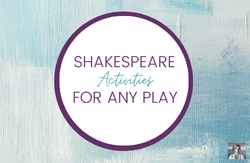
Teaching Shakespeare can be a mixed bag. On the one hand, it’s the bard! Whoo hoo! Perhaps the best writer in the history of humanity. On the other hand, the potential is definitely there for confused, disengaged, alienated students.
No one wants students to hate Shakespeare! That’s why I know you are ever on the lookout for creative strategies to help them connect with the great Will Shakespeare (Besides watching Shakespeare in Love , which I love, don’t you?).
Shakespearean Insults
Shakespeare’s use of insults are legendary. Share this TedEd video with them to introduce them to the concept, then give them a couple of minutes to check out the online Shakespeare Insults Generator with a partner. Have them write down the two they like the best to share with the class. Finally, have them go on a scavenger hunt through what you’ve read in search of great insults.

Acting Scenes with Character Costume Pieces
One of my favorite simple ways to read Shakespeare with my students is to bring in certain key character costume pieces and then do a lot of acting out during class. If I was reading The Tempest , for example, I might bring in a staff for Prospero, a wig for Miranda, a crown of flowers for Ariel, etc.
Then each day before we start, I do a few fun warm-up theater game s with my students, then choose the cast for the day to stand up and act (wearing the costume pieces). The cast changes every day, and I change out characters with tons of lines even within the class period, but the simple character costume pieces help keep things clear.
Shakespearean One-Pagers

Try out the popular strategy of having students represent the text visually on one page. Using a template will help them figure out what to put where. Divide up the paper and ask them to represent aspects of the text like symbolism, language, character development, etc. in different areas. Find out more and sign up for a free packet of four one-pager templates with complete instructions (a finished example is pictured above) here.
9 Unique Writing Activities
Hip hop / shakespeare connections.
I first read about this intriguing Ted Talk over on the Nouvelle ELA website. If your students are interested in hip hop, playing them this Ted Talk by a speaker from the Hip Hop Shakespeare company, and letting them consider the connections between hip hop and iambic pentameter, could be a really great point of connection.
The Game of Shakespeare’s Life and Shakespearean What-Ifs
If you’d like a fun and short activity to help engage students with Shakespeare as you introduce your play, check out Good Tickle Brain’s “ The Game of Shakespeare’s Life .” You can print out the game board and bring in your own dice for a quick little jaunt through Shakespeare’s bio. This could also be a fun springboard for having students make themed game boards of their own later in your unit.
The same website also has a set of funny Shakespearean “What If” comics , exploring what might have happened in various Shakespeare plays if one small thing had gone differently. You could share them with students and then have them make comics of their own.
Audio Clips: Tales from Shakespeare
On this website, you’ll find audio clips meant to be used to introduce various Shakespearean plays. If they have the play you are teaching (and the list is pretty long), you could play this audio on the first day as a way of bringing students into the world of the play.

The Lightning Version
This is a fun and EASY way to build a little performance into a study of any play. Ask small groups of students to script, rehearse and perform a lightning version of the scene, act, or entire play that you’ve just finished. You can make this lightning version 60 seconds, three minutes, five minutes, or whatever works for you.
Stress that they should work hard to hit the most important moments of the text in their lightning version. If you give this significant time, consider filming the performances for a fun class youtube channel you can add to year after year, showing examples from previous students when you introduce the project (and probably inspiring other classes in other locations to try it out).

Progressive Performance
My class performed A Midsummer Night’s Dream . All semester we worked on our costumes, wandered campus in search of the best set for our act, learned lines and practiced cues. We watched tons of video versions, rehearsed late at night, and generally dove as deeply into it as was possible.
Since taking part in this progressive performance in college, I’ve now done it two different years with my students, and it was amazing every time (four different classes X two different plays).
To make it a bit simpler for a smaller project, simply select crucial scenes from the play you are reading instead of having students perform full acts. Give them several rehearsal days throughout your unit, guiding them in choosing locations that they are allowed to use (have them get permission as needed!). They can come up with their own props and costumes, though these do not have to be too over-the-top for a successful performance.
On the final day, I like to give students theater awards sheets they can fill out as they watch the different performances. Filling these out gives them something to do in between performances, as the next group is setting up.
I hope you found something you want to add to your next Shakespeare unit! Please let me know which one you’re going to try in the comments.
Want to try a fresh discussion strategy that engages your students in critical thinking while also improving their group dynamics and creating that focused buzz of conversation in your classroom that you love? Try using my free digital hexagonal thinking kit. It has everything you need to get started with this popular classroom tool. Click here to sign up for this free resource.

I’ll help you find the creative ELA strategies that will light up your classroom. Get ready for joyful teaching!
LET’S BE PEN PALS
Browse by category.
SEARCH FOR THE STRATEGY OF YOUR DREAMS, OR DIVE INTO ONE OF THESE POPULAR CREATIVE RABBIT HOLES.

POPULAR POSTS

The ELA End-of-Year Checklist for a Better August

The Easiest Last Day in ELA

3 Years Overseas: The Highs & Lows of living abroad (as we prepare to say goodbye)

Need something great for tomorrow? Head on over to the free resources section.
Let’s hang out on

- PRIVACY POLICY
- TERMS AND CONDITIONS
Privacy Overview
| Cookie | Duration | Description |
|---|---|---|
| cookielawinfo-checkbox-analytics | 11 months | This cookie is set by GDPR Cookie Consent plugin. The cookie is used to store the user consent for the cookies in the category "Analytics". |
| cookielawinfo-checkbox-functional | 11 months | The cookie is set by GDPR cookie consent to record the user consent for the cookies in the category "Functional". |
| cookielawinfo-checkbox-necessary | 11 months | This cookie is set by GDPR Cookie Consent plugin. The cookies is used to store the user consent for the cookies in the category "Necessary". |
| cookielawinfo-checkbox-others | 11 months | This cookie is set by GDPR Cookie Consent plugin. The cookie is used to store the user consent for the cookies in the category "Other. |
| cookielawinfo-checkbox-performance | 11 months | This cookie is set by GDPR Cookie Consent plugin. The cookie is used to store the user consent for the cookies in the category "Performance". |
| viewed_cookie_policy | 11 months | The cookie is set by the GDPR Cookie Consent plugin and is used to store whether or not user has consented to the use of cookies. It does not store any personal data. |
Thanks for sharing this, I actually appreciate you taking the time to share with everybody. Data Science Course In Hyderabad With Placements
This is a really explainable very well and i got more information from your site.Very much useful for me to understand many concepts and helped me a lot. Best data science courses in hyerabad
keep up the good work. this is an Ossam post. This is to helpful, i have read here all post. i am impressed. thank you. this is our site please visit to know more information data science course in Hyderabad
http://www.thestyleref.com/2017/12/sports-fan-style-maxi-skirt-blazer-outfit-inspiration.html?showComment=1607516071893#c7498946393398366815
Leave a Reply Cancel reply
Your email address will not be published. Required fields are marked *
Save my name, email, and website in this browser for the next time I comment.
Ethical AI PBL Unit
3 weeks of attendance questions, better discussion toolkit.

Almost there!
- Grades 6-12
- School Leaders
Check Out Our 32 Fave Amazon Picks! 📦
29 Shakespeare Activities & Printables for the Classroom
A lesson plan! a lesson plan! My kingdom for a lesson plan!
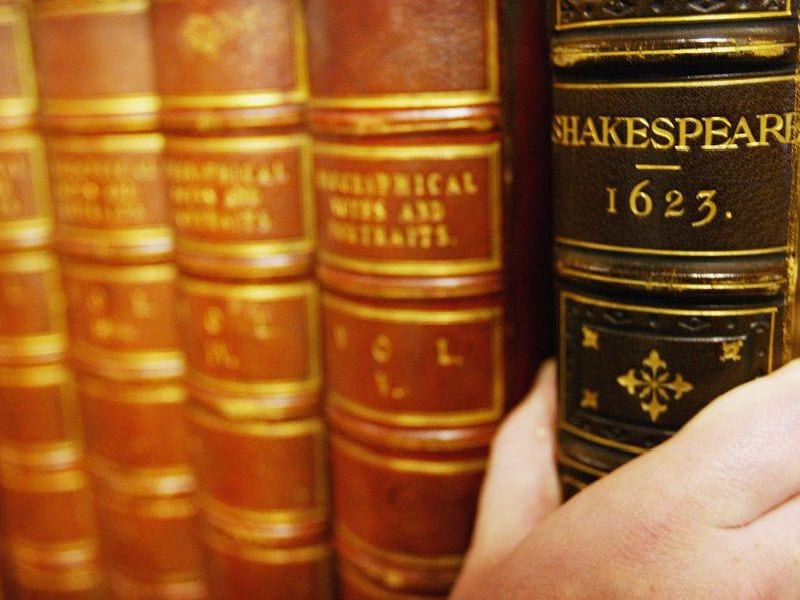
Think teaching Shakespeare is all toil and trouble? Methinks thou dost protest too much! These Shakespeare activities and printables will help you screw your courage to the sticking place and remember that the play’s the thing!
Shakespeare Activities
1. solve a cold case.
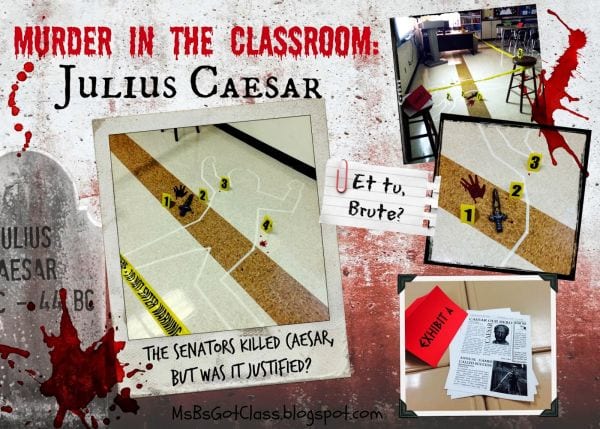
Ripped from the headlines! Set up a crime scene and challenge your class to find the motivation behind Caesar’s murder. Who says Shakespeare has to be boring?
Source: Ms. B’s Got Class
2. Craft Bumper Stickers
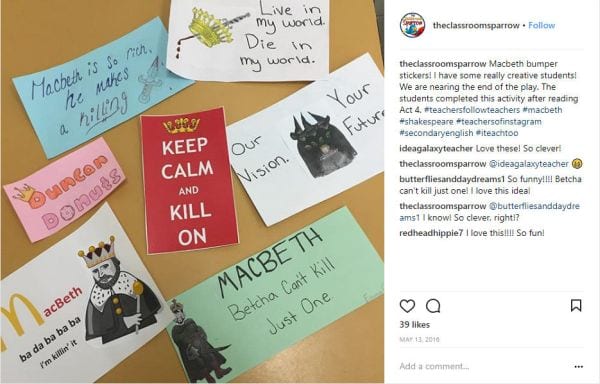
This works for any play. Have your students design bumper stickers! Simple concept but lots of room for creativity.
Source: theclassroomsparrow / instagram
3. Build a Globe Theatre Model
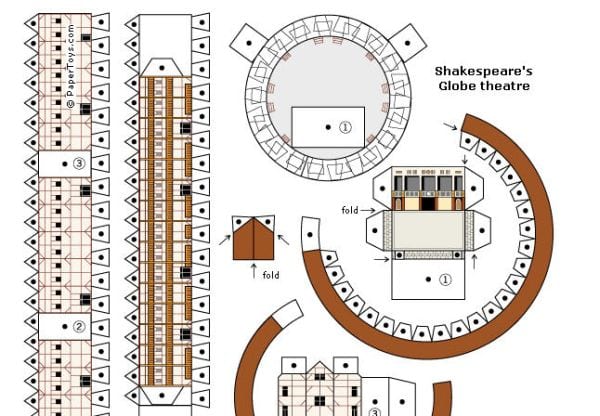
Knowing about the theater where Shakespeare’s plays were first performed is essential to understanding the plays themselves. Have your students build this simple paper model as you learn about the Globe Theatre.
Get it: Papertoys.com
4. Design a Mask for the Ball
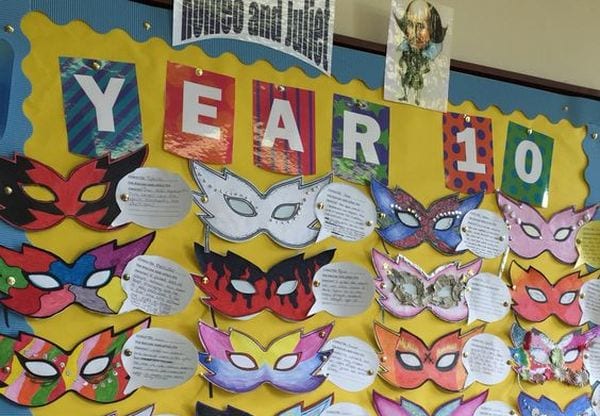
Have students create a mask for a specific character to wear to the Romeo and Juliet masquerade ball. They must justify their color and style choices for that character—a fun way to do character analysis.
Source: Lily Pinto / Pinterest
5. Transl8 a Scene 2 Txt
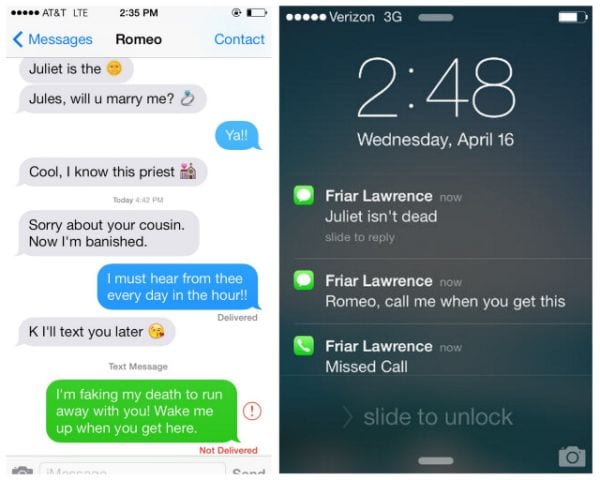
The language may be archaic, but the stories are endlessly modern. Have your class re-write a scene or sonnet in text, tweets, or other social media for a fun twist.
Source: fifteen eightyfour
6. Replace Words With Emojis
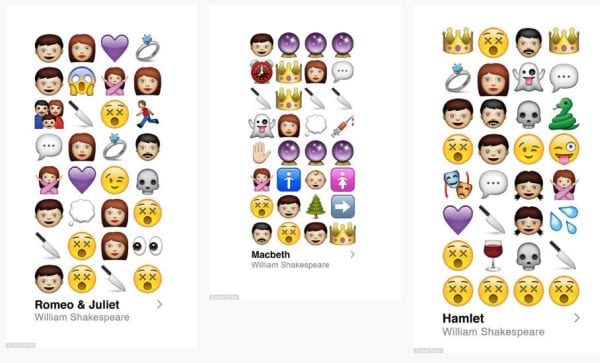
Take things a step further and remove words from the equation entirely! Have students devise book covers or re-write a scene or sonnet using only emojis to tell the tale. Discuss the difficulty of encapsulating some concepts in brief images and compare them with Shakespeare’s word choices.
Source: For Reading Addicts
7. Design a Book Cover
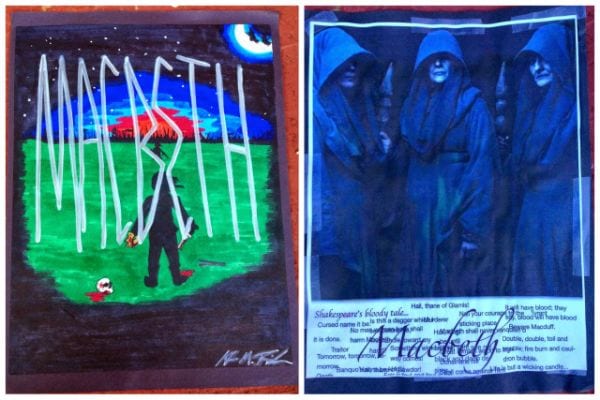
Combine art and graphic design with literature when you have kids originate book covers for a Shakespeare play. They make a fun classroom display too!
Source: Small World at Home
8. Dress the Part
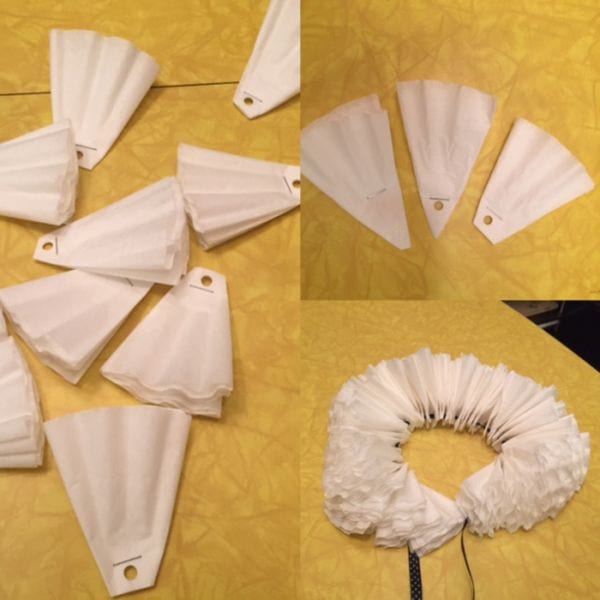
Dramatic readings are much more fun with a few props and costumes! This easy DIY paper ruff is made from coffee filters, and younger kids will love dressing up while they learn.
Source: Red Tricycle
9. Make Shakespearean One-Pagers
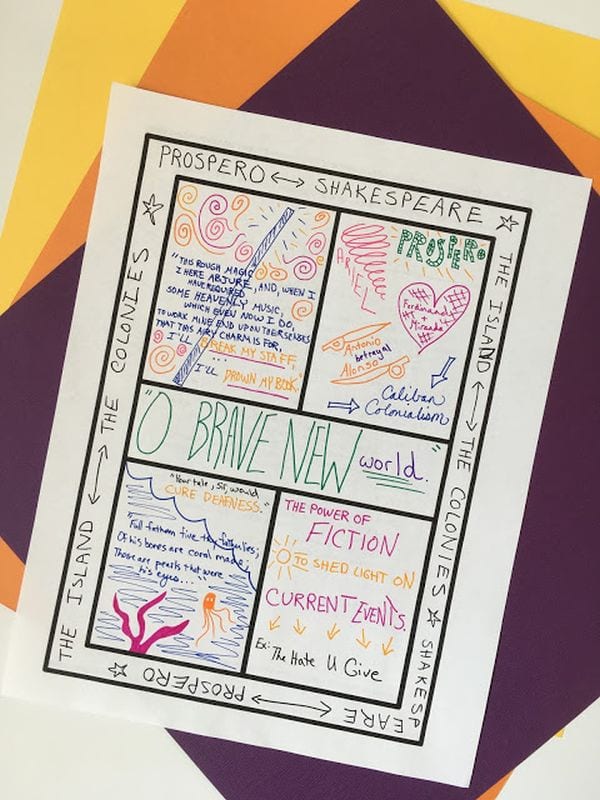
Challenge students to represent a play visually—all on one page. Templates are available at the link below to help get you started.
Source: Spark Creativity
10. Generate Word Clouds
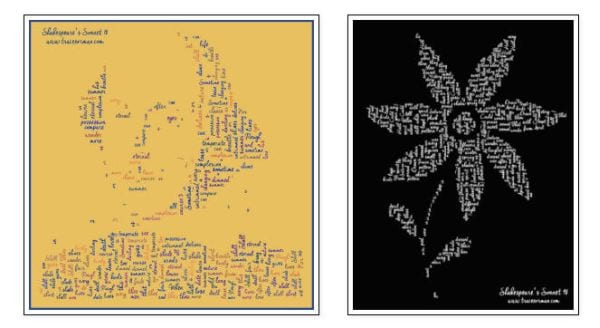
Use a computer program like Tagxedo or Wordle to build a word cloud identifying important words from a play or sonnet. (Tagxedo allows you to create word clouds in a variety of shapes.) Discuss these words and their importance.
Source: Mrs. Orman’s Classroom
11. Try Running Dictation
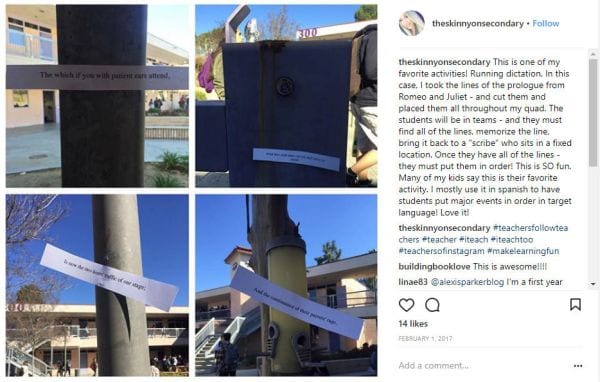
Get kids up and moving with “running dictation.” Print out a sonnet, prologue, monologue, or other important speech. Cut it up by lines and hang the sections up around a room or other area. Students find the lines, memorize them, report them to a scribe, and then put them in order.
Source: theskinnyonsecondary / Instagram
12. Fashion Upcycled “Laurel” Wreaths

Need some impromptu costumes for Julius Caesar or Coriolanus ? These clever “laurel” wreaths are made from plastic spoons!
Source: A Subtle Revelry
13. Write a Scene in Comic Form
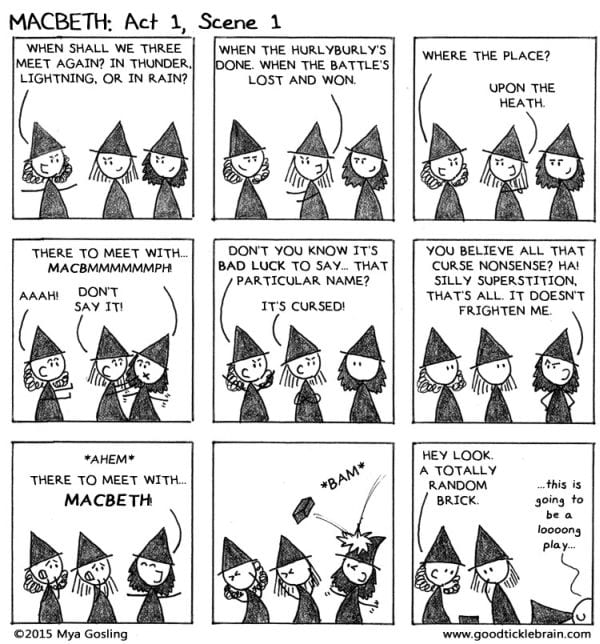
Like storyboarding, writing a scene in comic form helps capture the essence of the action. Kids can use the actual text from the scene or add in their own sense of humor. (Mya Gosling has re-written most of Macbeth in this form. For inspiration, check it out at the link below.)
Source: Good Tickle Brain
14. Write Concrete Poems
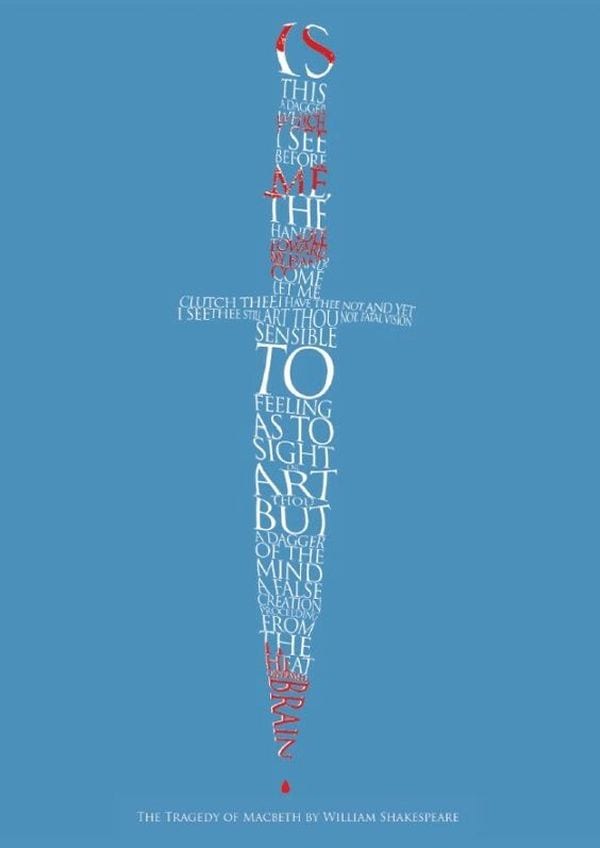
Turn pivotal quotes from a play into concrete poems, using shapes that represent the concept. Students can do this by hand or using the computer.
Source: Dillon Bruce / Pinterest
15. Stage Scene Snapshots
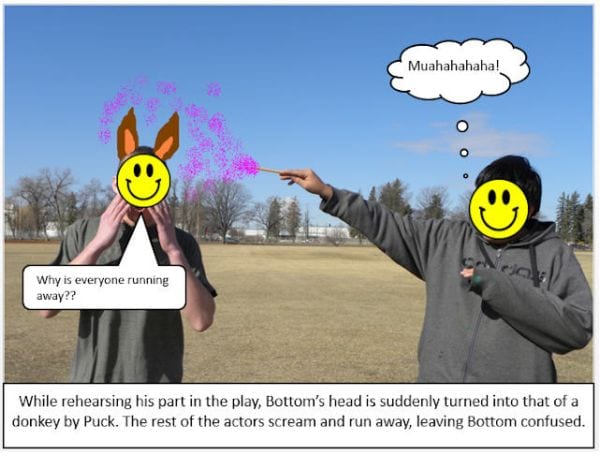
Performing an entire play takes a lot of time. Instead, have student groups stage scene snapshots capturing key moments from the play. Assemble them into a storyboard that covers the whole play.
Source: The Classroom Sparrow
16. Enjoy a Musical Interlude
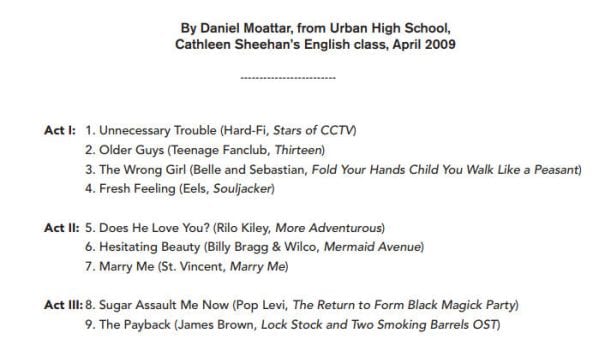
Compile a playlist for the play, act by act. Have students explain their song choices and listen to some of them in class.
Source: Cal Shakes R + J Teacher’s Guide
17. Write in Style
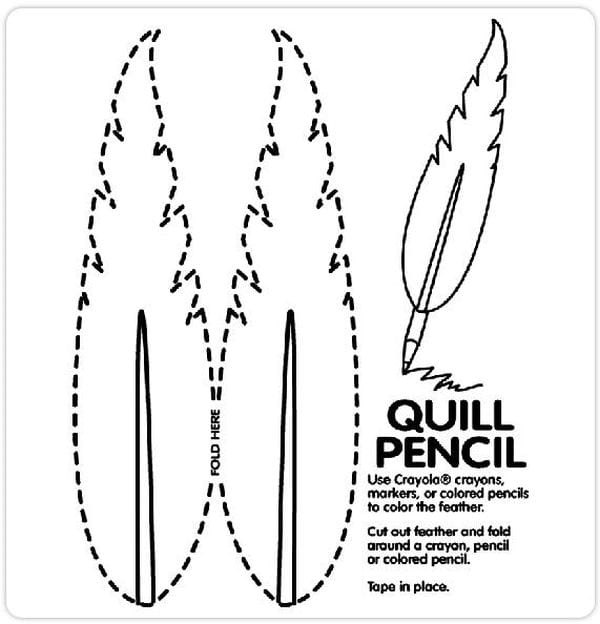
Get younger kids excited about Shakespeare when they write with their own “quill” pens. Color, cut out, and tape around a pen or crayon for old time fun!
Source: Crayola
Shakespeare Printables
18. william shakespeare coloring page.
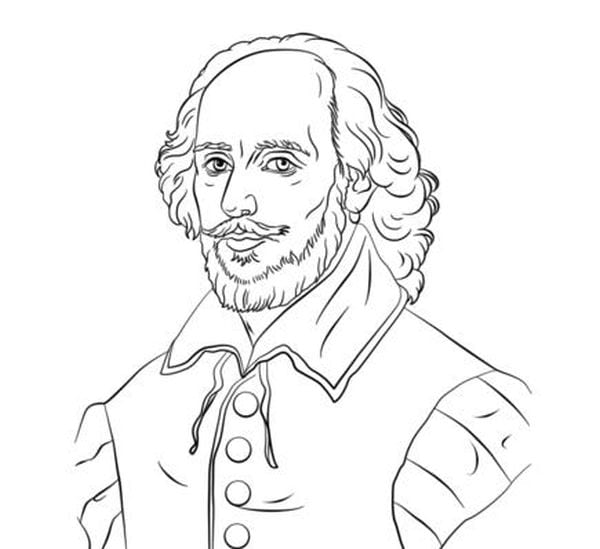
Meet the Bard! Use this coloring image to introduce Shakespeare to young readers or as an anchor for other creative activities.
Get it: Super Coloring
19. Cheer Up, Hamlet! Paper Doll
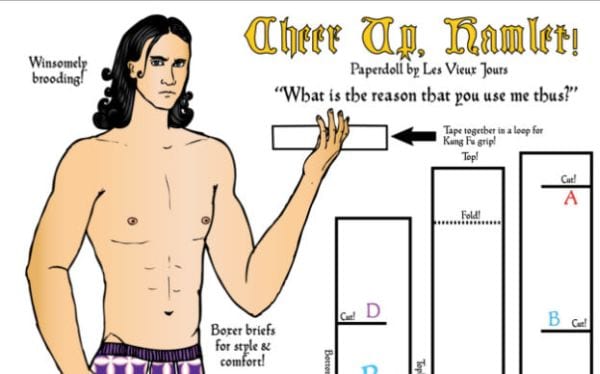
Have a little fun when teaching Hamlet . This free printable paper doll collection includes standard costumes but also hilarious extras like Captain Denmark and Doctor Who.
Get it: Les Vieux Jours
20. Shakespeare Mad Libs
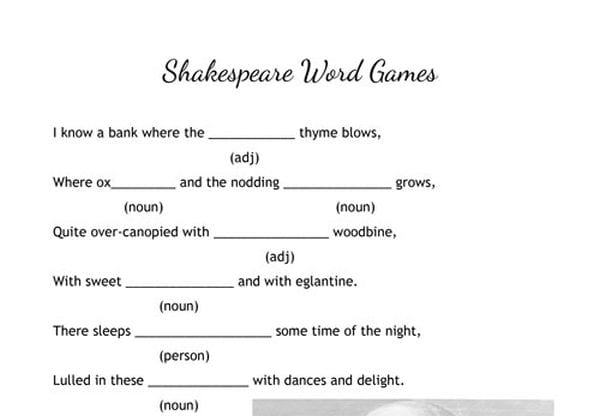
Remove key words from scenes or sonnets, fill in some new ones, and let the fun begin! Hit the link below for several pre-made games. You or your students can also make your own.
Get it: Homeschool Solutions
21. Shakespeare Lettering Sets
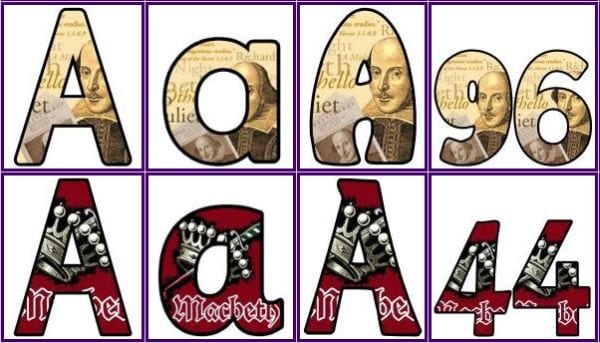
Download these free letter sets (one for general Shakespeare, one for Macbeth ) to create bulletin boards or other classroom displays.
Get it: Instant Display
22. Elizabethan Language Terms
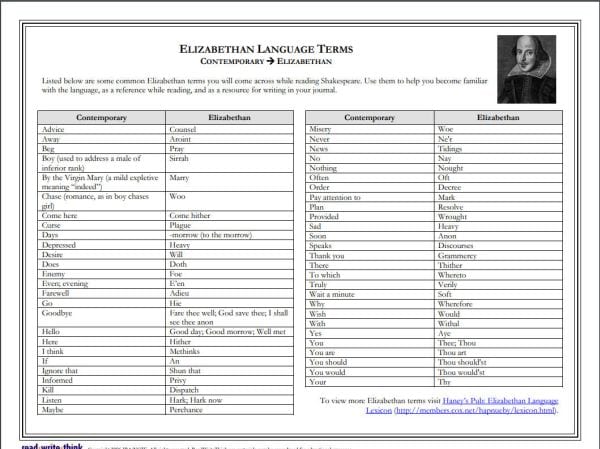
Print a copy for each student to keep handy as they tackle Shakespeare’s works.
Get it: readwritethink
23. A Midsummer Night’s Dream Coloring Pages
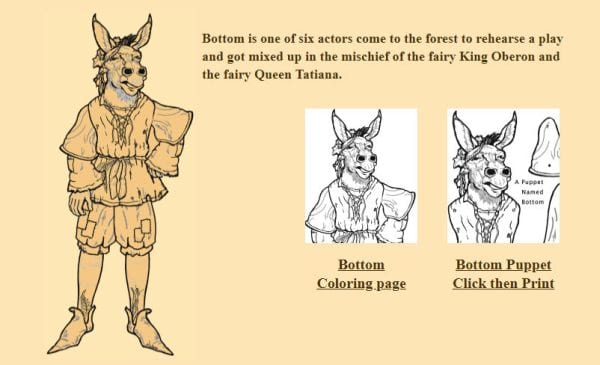
Introducing younger students to A Midsummer Night’s Dream ? These printable coloring pages and finger puppets are just the ticket.
Get it: Phee Mcfaddell
24. Phrases We Owe to Shakespeare Poster
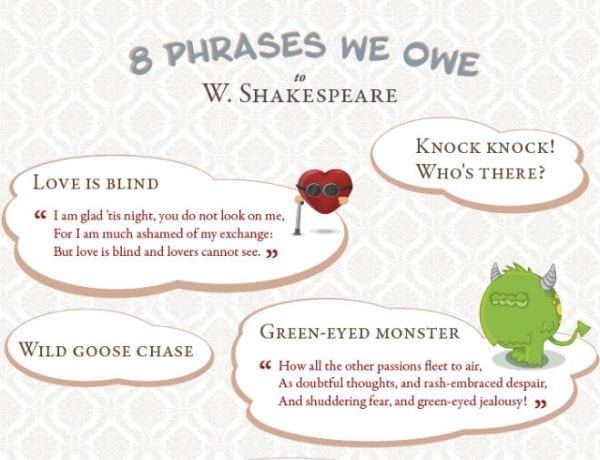
Shakespeare’s language becomes much more relatable when you realize how many of his phrases are still in use today . Hang this poster to introduce your students to some of these phrases.
Get it: Grammar.net
25. Shakespeare Notebooking Pages
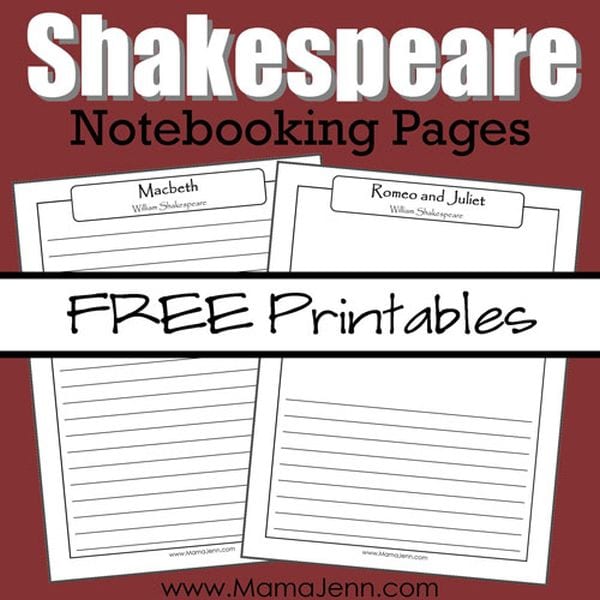
Keep students organized with these free printable notebooking pages for a variety of Shakespeare plays.
Get it: Mama Jenn
26. Shakespeare’s Life Poster
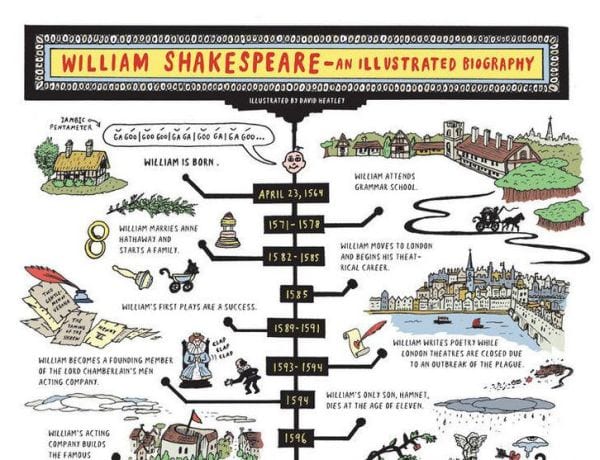
Hang this tongue-in-cheek timeline of the man himself to give students an overview of his life.
Get it: Imgur
27. Shakespeare Plays Word Search
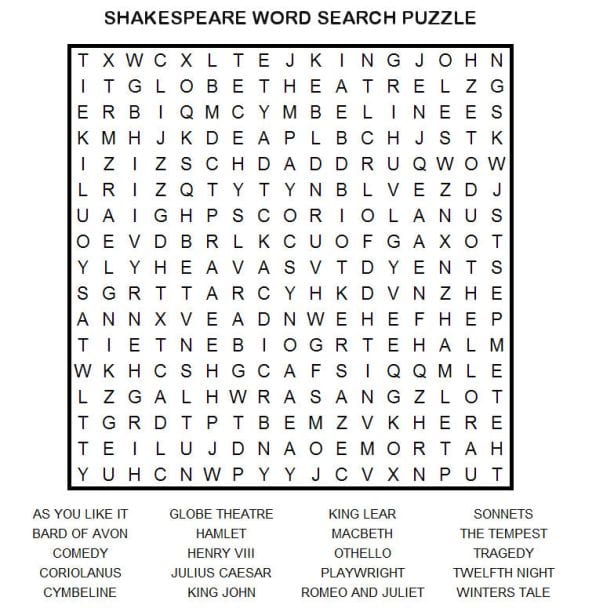
Print this simple word search to familiarize your class with Shakespeare’s plays.
Get it: Word Search Addict
28. Vintage Shakespeare Quote Printables
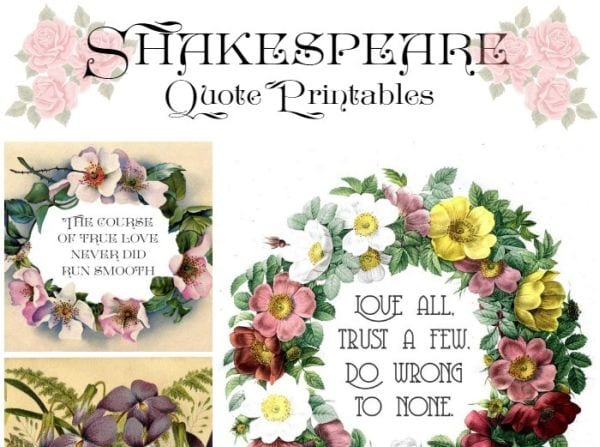
These pretty vintage images with Shakespeare quotes will add a touch of class to your classroom.
Get it: Mad in Crafts
29. Shakespeare Plays Flowchart
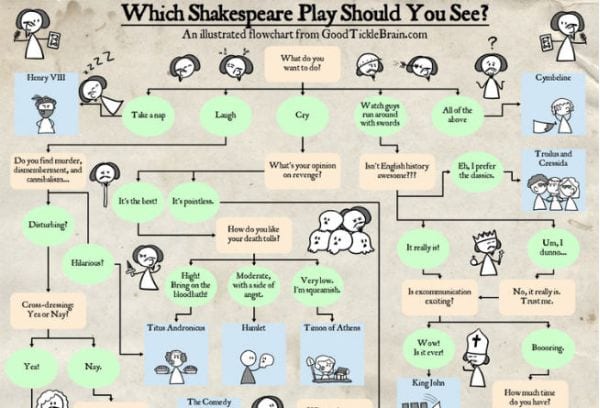
Wondering which Shakespeare play to see? This flowchart has got you covered! You can print your own version for free or buy a full-size poster.
Get it: Good Tickle Brain
What are your favorite Shakespeare activities and printables? Come and share in our WeAreTeachers HELPLINE group on Facebook.
Plus, How to Teach Shakespeare So Your Students Won’t Hate It .
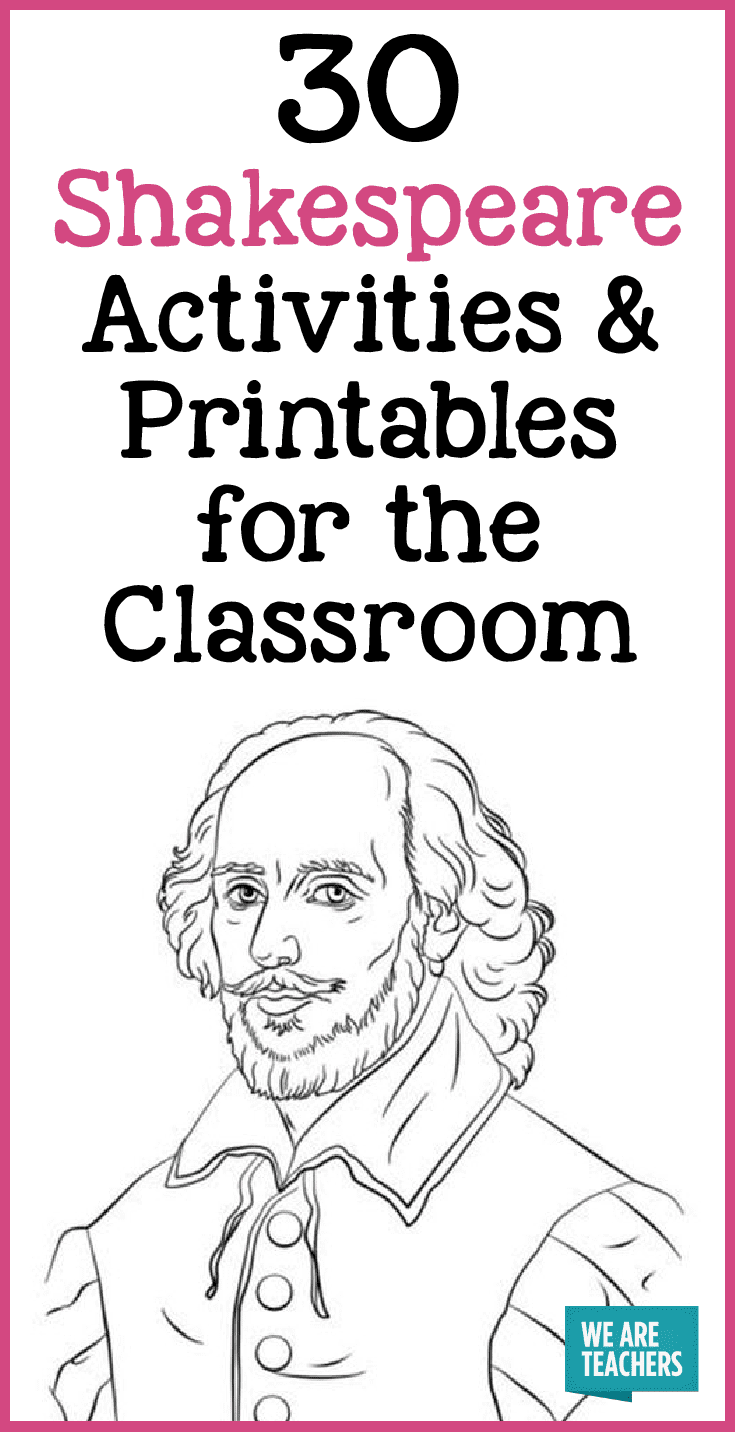
You Might Also Like
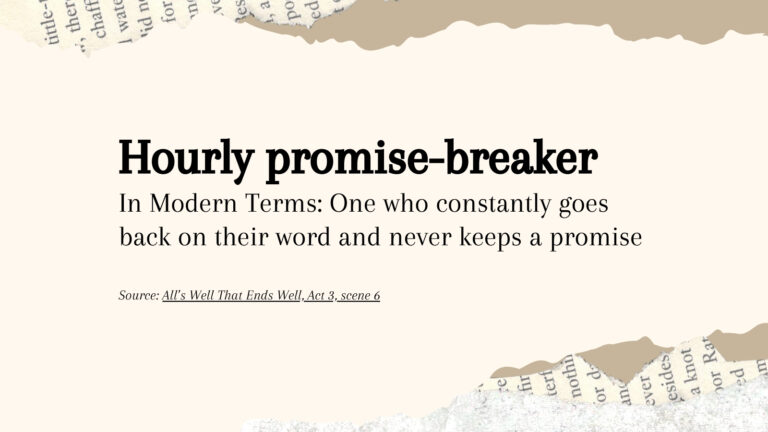
60 Best Shakespearean Insults That Win Verbal Duels
The Bard really knew how to throw shade. Continue Reading
Copyright © 2024. All rights reserved. 5335 Gate Parkway, Jacksonville, FL 32256
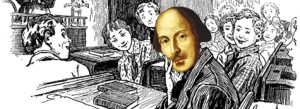
The Shakespearean Student
For shakespeare lovers of any age.

Activities For Students and Teachers: A Midsummer Night’s Dream
On this page, I’ll be posting resources, games, humor, and advice to children, teachers and parents on how to help Shakespeare come alive in the classroom. I’ve taught students ages 8-18 about Shakespeare and I can say confidently that Shakespeare can be enjoyed by anyone.
A Midsummer Night’s Dream: Activities for Teachers
Screenshot of Web English Teacher’s page for “A Midsummer Night’s Dream.”

Learning Goals:
- Engage the visual and kinesthetic intelligences of each student
- Encourage discussion about Shakespeare’s use of tone, sensory details, and allusion to create three different environments in the play.
- Guide the children to engage their imaginations as a director or set/costume designer would; drawing on the text, the real world, and on their own imaginations to interpret Shakespeare’s words.
Activity 1: Pre-K to 5 th : What Is a Fairy?
- Objective: To get the children thinking about how to visually design fairies, and thus interact with one of the key elements of this story:
- Materials needed: Printable pictures of fairies. There are hundreds of them on Pinterest, and I also found a couple at kidspot.com . I also found this site , for kids who want to make their own fairy wand!
- Safety scissors
- crayons, markers, or watercolors
- Setup Cut out pictures of Fairies for the kids to color.
- Present the kids with the pictures along with coloring implements.
- Description When you present your printable pictures to your students, ask them to imagine what a fairy looks like- what color is it, is it short or tall, does it have any powers? Where does it live?
- Have the kids answer these questions.
- You might want to have two volunteers hold up their fairies and act out a short passage like this one:
- PUCK How now, spirit! whither wander you?
- Fairy Over hill, over dale, Thorough bush, thorough brier, Over park, over pale, Thorough flood, thorough fire, I do wander everywhere, Swifter than the moon’s sphere; And I serve the fairy queen, To dew her orbs upon the green. Midsummer, Act II, Scene i, Lines 1-9.
Activity 2: High School grades 9-12: The Real Housewives of Athens!
- Objective: To get the students to think of the Lover’s Quarrel Scene ( Act III, Scene ii ), in contemporary and relevant terms.
- Materials needed: Any edition of Midsummer , paper, pencil, and four volunteers (pref 2 male and 2 female).
- Description: Have your students translate the lover’s quarrel as a fight between 21 st century people on a talk show with a title like: “My man has taken a magic love potion, and doesn’t want me anymore,” with Puck as the host.
- As your actors write the script, remind them of what happens in the scene:
- Demetrius and Lysander, who used to love Hermia, now both love Helena, and are willing to fight to the death for her!
- Helena, unwilling to believe that anyone would love her, believes all three of them are playing a cruel joke on her. She therefore is very hurt and angry at everyone else.
- Hermia believes that Helena has stolen Lysander’s heart from her and is furious at Helena.
- Puck, thinks the whole affair is hilarious, which is why he is a good host for this “show.”
- According to the stage directions, Hermia lunges for Helena’s eyes and the men restrain her. If you choose to do this, be sure to practice it so nobody gets hurt.
- Stage both versions the scene (Shakespeare’s and theirs) before the class.
- Ask the kids:
- Did they learn about the scene by paraphrasing it?
- Is the scene funny?
- Did you find yourself sympathizing with any of the characters?
Activity 3: College to Adult: Visual Art of Midsummer Nights’ Dream Project
- Objective: Design costumes and setting for Dream to get the students thinking about the visual language of the play, which takes place in three very distinct locations.
- Materials needed- depends on the format
- Theater costume/ design sketch pad, fabric swatches, cardboard, etc .
- Video : Pictures or video clips.
- Collage: Pictures from magazines, newspapers, old books, etc.
Setup- Collect visual images that capture what you think of when you think of the locations in Midsummer Nigh’s Dream. Use one of the suggested media above to present your visual brand to the class.
- Description Find pictures of various locations or clothing to create a visual style for your production of A Midsummer Night’s Dream, which can exist in any place or time past, present, or future.
- Collage Create three different collages for Athens, the Forrest, and the home of Bottom the Weaver. What kind of words and pictures embody these locations?
- Put your pictures in a slideshow or video such as the one above.
- Costume Design If you have real artistic talent, you can create a design like a real costume or set designer would:
- You can create a sketch of how each character might look, complete with fabric swatches to indicate how they might be dressed.
Lesson Plans from the Web
- Folger Shakespeare Library: Shakespeare the Player by Caitlin Griffin and Carol Ann Lloyd Stanger. Students act out the scenes with Bottom and the other Mechanicals and discover what life was like for Elizabethan actors.
- Royal Shakespeare Company: Teachers Pack for A Midsummer Night’s Dream . A complete educator’s packet with games, discussion questions, and suggested scenes to act out.
- Web English Teacher: A Midsummer Night’s Dream. A series of videos, teachers’ guides, and handouts for quick explanations of the plot and characters.

Share this:
2 thoughts on “ activities for students and teachers: a midsummer night’s dream ”.
- Pingback: Happy Teacher Appreciation Week! – The Shakespearean Student
- Pingback: Wrapup on “A Midsummer Night’s Dream” – The Shakespearean Student
Leave a comment Cancel reply

- Already have a WordPress.com account? Log in now.
- Subscribe Subscribed
- Copy shortlink
- Report this content
- View post in Reader
- Manage subscriptions
- Collapse this bar

- Schools and Teachers
- Teacher Resources
Tales From Shakespeare Resources
Discover writing activities and ways into teaching literacy, inspired by Michael Morpurgo's Tales from Shakespeare

Created in collaboration with Jan Anderson, an RSC Associate School teacher from Springhead Primary School, these resource packs offer brilliant ways into teaching writing outcomes as part of your study of Shakespeare at KS1-3. For suggestions on how to adapt activities for remote and home learning please take a look at the suggestions on this page.
- A Midsummer Night's Dream - Literacy Pack 2021
- Macbeth - Literacy Pack 2021
- The Tempest - Literacy Pack 2021
- Romeo and Juliet - Literacy Pack 2021
Adapting Rehearsal Room Approaches for Home Learning
Following years of working with young people and teachers we know that the best writing is produced as a result of working actively with Shakespeare's text and language, as actors do in a rehearsal room. However, we also realise that remote learning means that many of the activities in these packs will need to be adapted.
Below are some suggestions for how to do this, which we hope are helpful.
- Freeze frames and still images - many of the exercises involving freeze frames and images can still be done online in a remote session by asking pupils to create their own statues, or to collect objects that represent a word or character and share them on screen. If the lesson is not being held online, but tasks are being set and completed remotely, you might also encourage pupils to make their freeze frames with toys or family members and photograph them to submit. Whenever you asking pupils to share images or convey something visually on screen it can also help to ask other pupils to turn off their cameras.
- Performances and group work - with older pupils, much of the group work in these resources can be completed in breakout groups online. This depends on the method your school is using to deliver lessons, but can also be a great way for pupils to rehearse readings of the scenes or text they are working on. As they can't perform together, it is also a good idea to ask groups to divide the lines between them and then create movements or gestures to help convey their individual line. This means pupils can still share creative work, and think collectively about the imagery in the words. Challenging pupils to create short films and storyboards for scenes that they then present together can also help them to think in similar ways.
- Text scraps and extracts - several activities in these resources require you to lay out text or lines from the play on the floor, asking pupils to write on them and add to them and imagine the worlds they describe. This can also be done by sharing these lines on screen, and asking pupils to annotate them together (if this function is available to you), or to do this independently or in groups so you can then share good examples. Introducing short extracts in this way is important for younger pupils, building up their awareness and confidence around Shakespeare's text.
Ask Michael
In these films, actor Nadi Kemp-Sayfi asks Michael Morpurgo questions sent in from schools. Watch below to find out his thoughts on Shakespeare and how he gets the best out of his writing.
- Rehearsal Room Approaches to Shakespeare
- Activity Toolkits
- Interactive Learning Resources
- Teaching Shakespeare
- Matilda The Musical Resources
- Shakespeare Lives in Schools
- RSC School Shakespeare
- Romeo and Juliet Pack 2024
You may also like

Shakespeare's Globe

Macbeth: Themes KS4/5
In these lessons, students will engage with the themes and ideas at the heart of the text, including deception, ambition, and guilt. Tasks include: tracking these themes throughout the play, drawing out key quotations; creative writing on Lady Macbeth's sleep walking, in the character of her doctor; and a list of practice exam questions with an emphasis on themes and motifs.
In order to benefit fully from these lesson plans, we recommend you use them in the following order:
- Text in Performance
If you would like to teach the play in greater detail, use these advanced KS4/5 Lesson Plans. If students are new to the play, we suggest you start with the introductory KS3 Lesson Plans .
These lesson plans are available in the Downloads section at the bottom of this page. To download resources, you must be logged in. Sign up for free to access this and other exclusive features . Activities mentioned in these resources are available in a separate downloadable 'Student Booklet', also at the bottom of this page. The 'Teachers' Guide' download explains how best to use Teach Shakespeare and also contains a bibliography and appendices referencing the resources used throughout.
Key Questions for Students:
Can I identify why the themes of appearance and reality are important and pick out examples from throughout the text?
Can I explain the importance of these examples by placing them in the context of the play as a whole and the overall development of these themes?
Key words: appearance, deception, plot, reality, theme, thought-tracking
Prologue: Opening Discussion
Introduce the theme of appearance and reality and display a quiz-show style board numbered 1-25. Students should pick one square and if it reveals a quotation, they should place that quotation in context and talk about how it connects with the theme of appearance and reality. As a class, students should try to make a full line of five quotations across or down the board. But beware, as some squares will have something much more dangerous behind them (pictures of daggers, witches, blood, etc.) Give students a fixed amount of time or a fixed number of attempts to increase the excitement! Some suggested quotations you could use are included in the Asides.
Enter the Players: Group Tasks
1) Tracking the theme
Students should use the mindmap to help them track the theme of ‘appearance and reality’ in the play. Students could be divided into five groups, each taking one Act from the play. They should read through it carefully, looking for evidence before reporting back. Students could also prepare a sheet of evidence that can be made accessible to all their classmates as a revision aid. Students should aim to keep quotations short (under 10 words), and write a brief commentary about how their quotation links to the overall theme.
2) Exploring more deeply through drama and creative writing
The following drama activities can support students’ further explorations of this theme:
- Yes/No game: One student is chosen or volunteers to answer questions. They must answer any questions asked of them by the rest of the class without saying ‘Yes’ or ‘No’, and they should aim to be as inventive as possible. The discussion that follows this game could encourage students to think about how language can be used to get around giving a direct and simple truthful answer. Jessica Swale suggests this activity can work ‘as an effective prelude to playwriting exercises’.
- the mouth card means that they should say or paraphrase a line they say in the scene (not an aside)
- the head card means that they should talk about what they are really thinking
- the heart card means that they should talk about how they are feeling at this moment
3) Interpreting and staging key scenes
Assign to groups of students the task of staging a scene where they feel this theme is crucially important, e.g. Act 1 Scene 3, Act 1 Scene 4 or Act 2 Scene 2. Afterwards, reflect as a group and as a whole class on how well the various performances explored the themes of appearance and reality and how this was achieved.
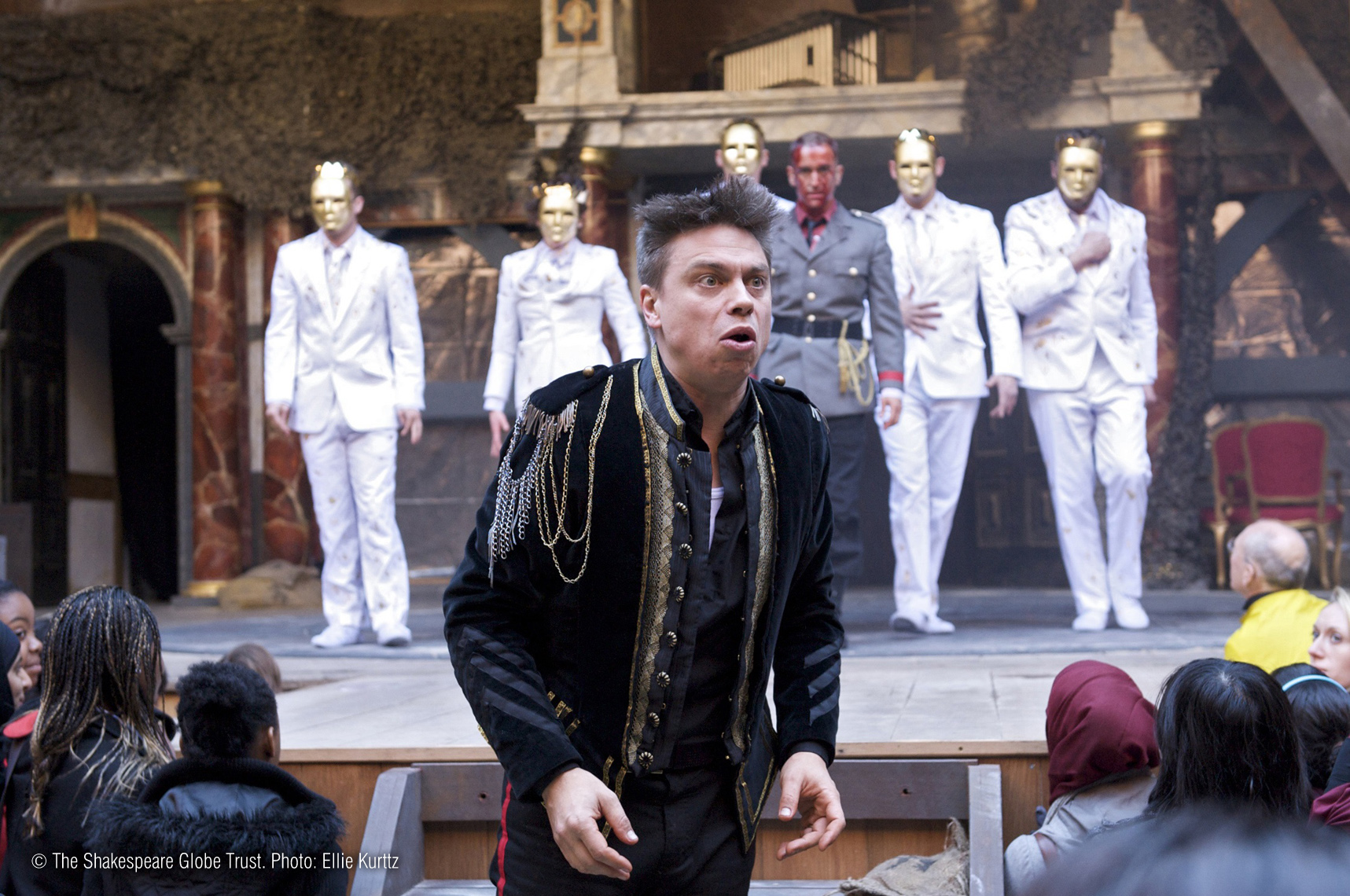
Exeunt: Closing Questions for Students
Why are appearance and reality important themes in the play?
How would I describe the development of these themes throughout the play?
How do these themes link to the other major themes in Macbeth that I have studied?
Suggested plenary activity…
Everyone in the class picks out three key moments that they think are particularly crucial when thinking about the themes of appearance and reality. Compare findings.
Asides: Further Resources
Quotations you could use in the Prologue activity:
- “Fair is foul, and foul is fair”
- “Are ye fantastical, or that indeed/Which outwardly ye show?”
- “…why do you dress me /In borrow’d robes?”
- “There’s no art/To find the mind’s construction in the face.”
- “Let not light see my black and deep desires.”
- “…look like th’innocent flower,? But be the serpent under it.”
- “This castle hath a pleasant seat.”
- “False face must hide what the false heart doth know.”
- “…art thou a dagger of the mind/A false creation”
- “If he do bleed,/I’ll gild the faces of the grooms withal,/For it must seem their guilt.”
- “…sleek o’er your rugged looks;/ Be bright and jovial among your guests to-night.”
- “This is the very painting of your fear.”
- “A great perturbation in nature, to receive at once the benefit of sleep, and do the benefits of watching.’’
- “…now does he feel his title/ Hang loose about him, like a giant’s robe/Upon a dwarfish thief.”
- “As I did stand my watch upon the hill,/I look’d toward Birnam, and anon, methought,/The wood began to move.”
Epilogue: Teacher's Note
Additional materials about studying the witches can be found in the Text in Performance , Language and Context sections.
Can I identify why the themes of power and ambition are important and pick out examples from throughout the text?
Can I explain the importance of these examples by placing them in the context of the play as a whole and the overall development of this theme?
Key words: allegiance, ambition, divine right of kings, heir, hierarchy, legitimacy, power, sovereign, status, succession, theme, tyrant
Ask students to complete a vocabulary exercise matching the following words with definitions:
power – the ability to do something or direct what others do
sovereign – a supreme ruler
heir – a person legally entitled to the property or rank of another person when that person dies
tyrant – a cruel and oppressive ruler
ambition – desire and determination to be successful
succession – the process of inheriting a title, office or property
legitimacy - lawfulness
the divine right of kings – the idea that the monarch’s right to rule comes directly from will of God
allegiance – the loyalty of a subject to his or her ruler
dynasty – a sequence of rulers from the same family
Then ask students to choose a word and write one or two sentences about Macbeth using that word. Students should share their sentences with their partners. The partner awards:
- 1 point for correct use of the word in a sentence
- another 1 point for using the word in reference to Macbeth , and
- up to another 2 points for including a short and relevant quotation
Students should use the mindmap to help them track the theme of ‘power’ in the play. Students could be divided into five groups, each taking one Act from the play. They should read through it carefully, looking for evidence before reporting back. Students could also prepare a sheet of evidence that can be made accessible to all their classmates as a revision aid. Students should aim to keep quotations short (under 10 words), and write a brief commentary about how their quotation links to the overall theme.
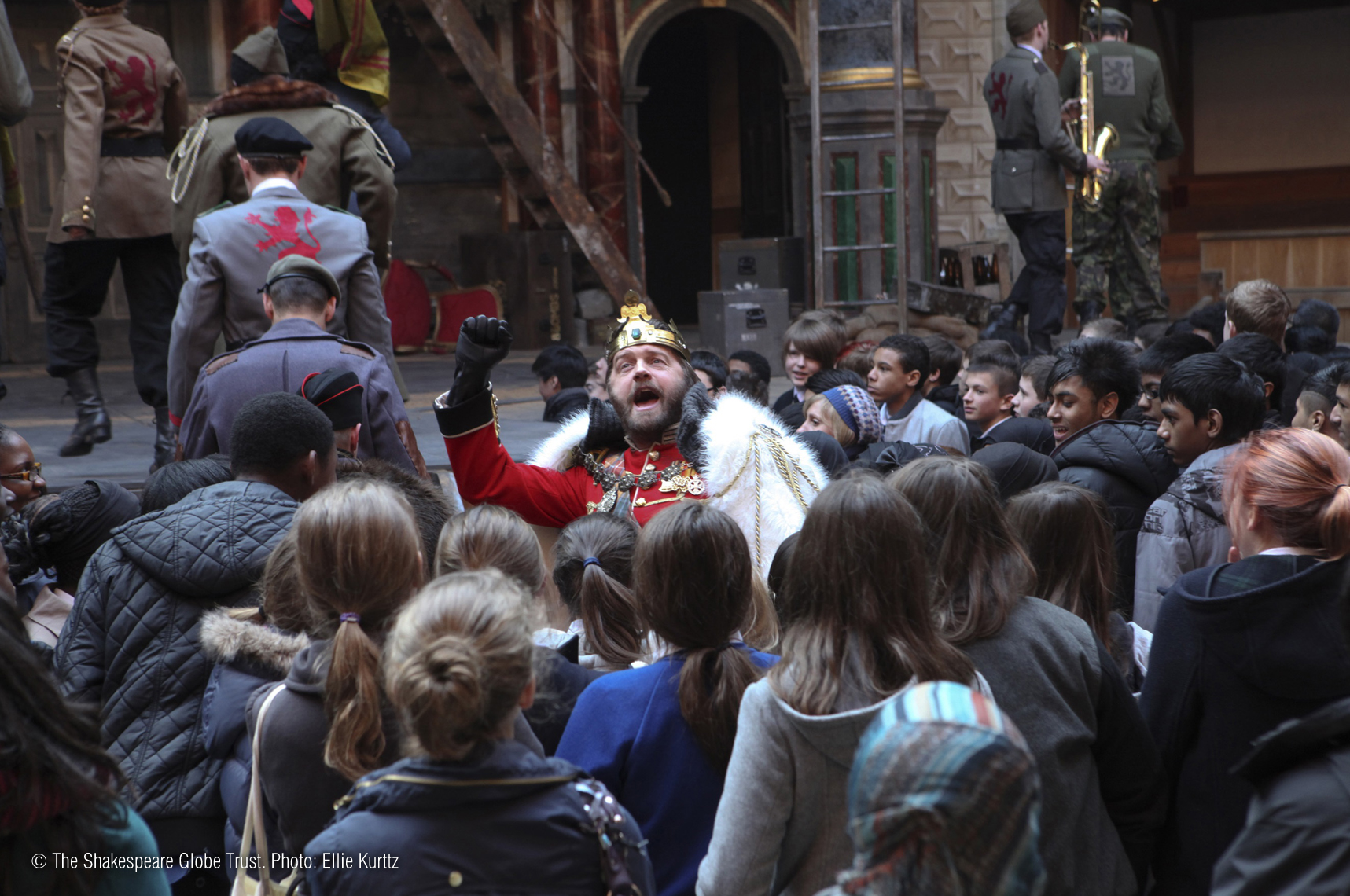
2) Exploring more deeply through drama
The following drama activities can support students’ explorations of this theme. Students could reflect on their experiences of these exercises in the Student Booklet.
- The King says… This is basically a version of Simon Says that will help students to listen carefully and to respond physically to some but not all of the instructions. The actions could be appropriate for a king’s armies/subjects/servants, e.g. stand to attention, bow deeply, beg for forgiveness. You could even differentiate between the kinds of things ‘King Duncan says’ and the things that ‘King Macbeth says’, obeying only one and not the other and then switching.
- Pauper to prince: Students build a cumulative freeze frame indicating relative status from pauper to prince. Encourage attention to body language, eye contact, etc. and ask each new student to think about how their pose builds on the one before it. Finally, ask students to think about how the status of the highest status actors could be undermined, e.g. pulling a face behind their backs, pretending to direct them in a play, putting a gun to their head.
Assign to groups of students the task of staging a scene where they feel this theme is crucially important, e.g. Act 1 Scene 4 or Act 5 Scene 9. Afterwards, reflect as a group and as a whole class on how well the various performances explored the themes of power and ambition and how this was achieved.
Why is power an important theme in the play?
How would I describe the development of this theme throughout the play?
How does this theme link to the other major themes in Macbeth that I have studied?
Everyone in the class picks out three key moments that they think are particularly important to bear in mind when thinking about the theme of power. Compare findings.
- Students can read more about the theme of ambition on the Playing Shakespeare with Deutsche Bank Macbeth microsite here: 2011.playingshakespeare.org/themes-and-issues/ambition
- Students could research the ideas of the Renaissance diplomat and political theorist Niccolo Machiavelli, and compare them with some of the ideas about power and politics in Macbeth .
Additional ideas about exploring the concepts of power and status - including some rehearsal room approaches to try out - can be found within the Key Stage 3 materials .
Can I identify why the themes of family and succession are important and pick out examples from throughout the text?
Key words: descendants, divine right of kings, dynasty, family, heir, succession, theme
Display the five quotations/images connected with the themes of family and succession. (The quotations are featured in the Student Booklet.) What’s the connection?
- “how tender ‘tis to love the babe that sucks me” quotation (Lady Macbeth)
- “all my little chickens” quotation (Macduff)
- picture of apparition of a child carrying a tree
- “from his mother’s womb untimely ripp’d” quotation
- an image of Banquo and Fleance
Draw out from students’ feedback some of the ideas and issues to help them connect the clues, such as family, children, mothers and fathers, birth, descendants, succession, the divine right of kings, blood, dynasties, the future. Students could record them in a mindmap. A key idea with this theme is for students to think about families in a political as well as personal way. You could draw parallels with the current Royal Family to illustrate this point.
1) Tracking the theme
Students should use the mindmap to help them track the themes of ‘family and succession’ in the play. Students could be divided into five groups, each taking one Act from the play. They should read through it carefully, looking for evidence before reporting back. Students could also prepare a sheet of evidence that can be made accessible to all their classmates as a revision aid. Students should aim to keep quotations short (under 10 words), and write a brief commentary about how their quotation links to the overall theme.
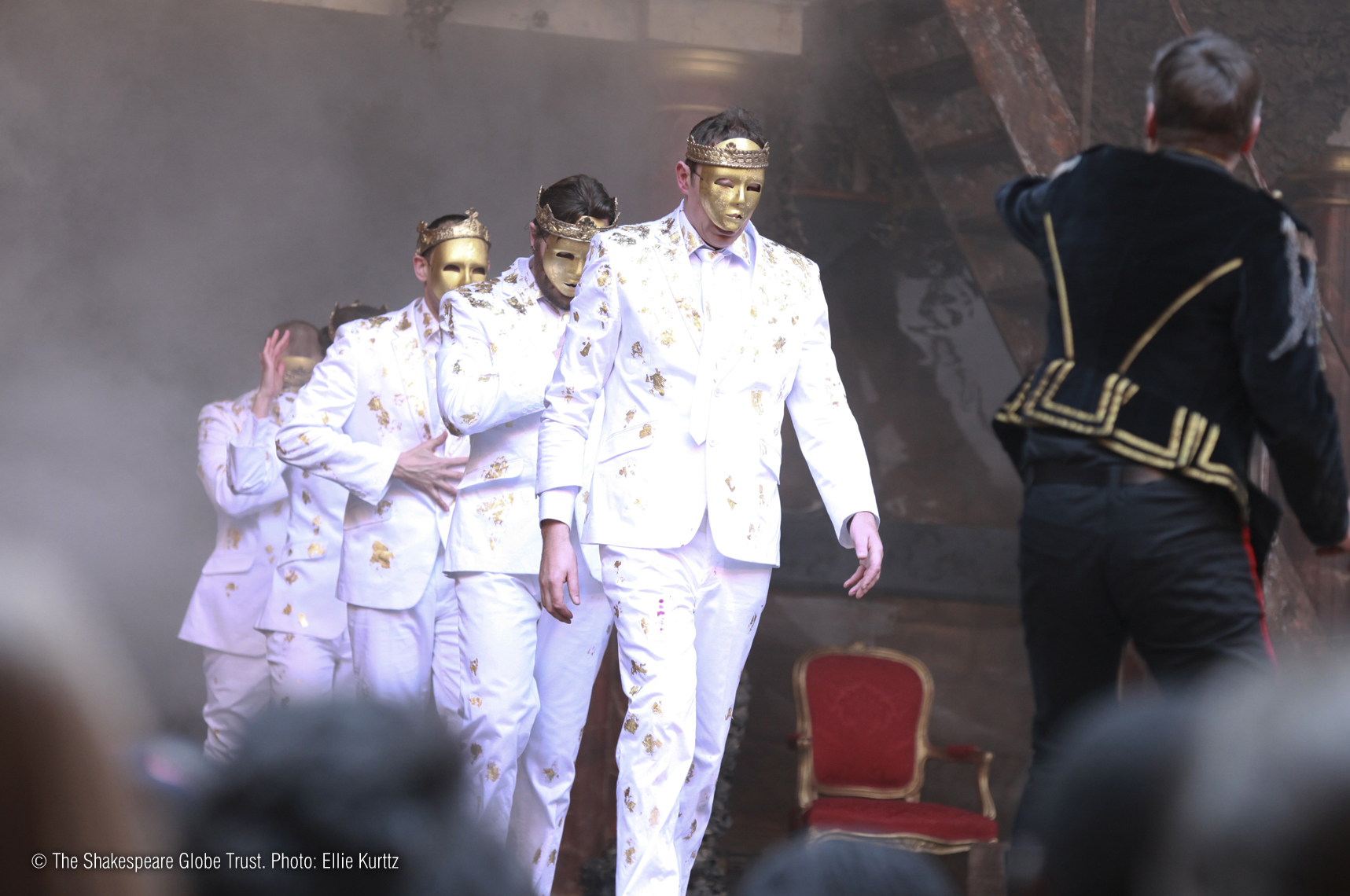
- Wolf and sheep: one student is the wolf, one the sheep and the rest of the class hold hands and create a protective ‘fold’, who must move as one to protect the sheep in their care
- how the portraits would look before/during/at the end of the play
- the number of father/son images and the relative absence of women/mothers
- the issue of whether the Macbeths have lost a child in infancy
Assign to groups of students the task of staging a scene where they feel this theme is crucially important, e.g. Act 4 Scene 1 or Scene 2. Afterwards, reflect as a group and as a whole class on how well the various performances explored the themes of family and succession and how this was achieved.
Why are family and succession important themes in the play?
Everyone in the class picks out three key moments that they think are particularly important to bear in mind when thinking about the theme of family and heredity. Compare findings.
- Succession was an important issue for Shakespeare’s audiences as Queen Elizabeth (a Tudor) had had no children. When she died in 1603, James VI of Scotland (a Stuart) also became James I of England. James chose Shakespeare and his fellow actors as his royal company and three years later, Shakespeare wrote Macbeth about the Scottish succession.
- The play centres on the fortunes of Macbeth and those characters whose fortunes are directly implicated in Macbeth’s quest for power: Lady Macbeth, Duncan, Malcolm, Banquo and Macduff. Whose stories are left open-ended at the end of the play? Are there any questions that Shakespeare leaves unanswered?
For more on this theme, look for activities in the sections about Character and Themes .
Can I identify why the themes of guilt and conscience are important and pick out examples from throughout the text?
Key words: anxiety, depression, doubt, hallucination, mental illness, mind, obsession, suicide, theme
Begin a ‘mind’map with a picture of a brain in the middle on to which the class can contribute ideas about how Shakespeare explores the way the mind works in Macbeth . Possible ideas include:
- characters experiencing hallucinations/visions (the mind playing tricks or genuine supernatural occurrences?)
- anxieties/doubts about turning plans into actions
- becoming obsessive about something/craving something, etc.
- how what we say and what we think can be very different
- sleepwalking/insomnia
- mental illness/depression/suicide (what does happen to Lady Macbeth?)
Students are going to track the themes of guilt and conscience throughout the play. Students could be divided into five groups, each taking one Act from the play. They should read through it carefully, looking for evidence before reporting back. Students could also prepare a sheet of evidence that can be made accessible to all their classmates as a revision aid. Students should aim to keep quotations short (under 10 words), and write a brief commentary about how their quotation links to the overall theme.
2) Exploring more deeply through creative writing
Read Act 5 Scene 1 in small groups or as a class or watch the scene in performance. Discuss what the scene reveals about Lady Macbeth’s thoughts and feelings about killing Duncan. Compare this against her thoughts and feelings earlier in the play, e.g. in Act 1 Scene 5, Act 1 Scene 7 and Act 2 Scene 2. Students should make notes in the Student Booklet, using cross-referencing to draw parallels and contrasts between this and other scenes.
Next, ask students to imagine they are either the Doctor or the Waiting Gentlewoman from Act 5 Scene 1. They have witnessed Lady Macbeth’s mental state and have heard her talk in an incriminating way about the king’s murder. Imagine what they might write in their private diaries. Think about how each character would react to her as a person and as a political figure now that they know what they do. What should they do next? Students could continue the diary to include an account of subsequent events too.
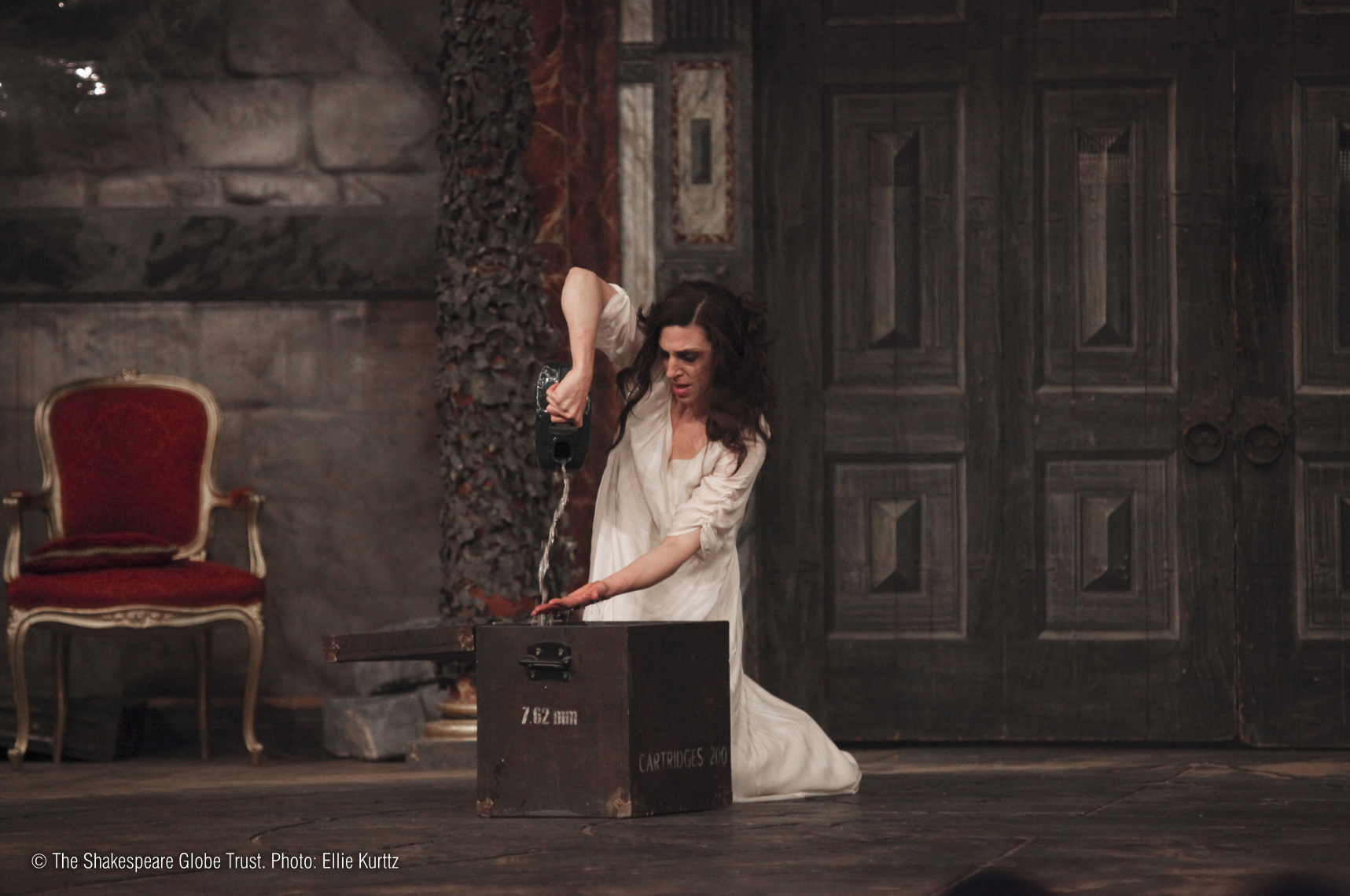
3) Interpreting and staging key scenes
Assign to groups of students the task of staging a scene where they feel this theme is crucially important, e.g. Act 2 Scene 1, Act 2 Scene 2, Act 3 Scene 2 or Act 4 Scene 3. Afterwards, reflect as a group and as a whole class on how well the various performances explored the themes of guilt and conscience and how this was achieved.
Why are guilt and conscience important themes in the play?
How would I describe the development of these themes throughout the play?
Everyone in the class picks out three key moments that they think are particularly important to bear in mind when thinking about the theme of the human mind and its frailties. Compare findings.
- Draw together the evidence about Lady Macbeth’s mental condition and eventually her death from Act 5 Scenes 1, 3 and 5. What can we infer from these scenes about attitudes to and understandings of the human mind in Shakespeare’s time?
The creative writing task could be dual assessed for reading and writing.
Can I write about the themes of the play in a connected and coherent way?
Can I demonstrate confidence in my handling of abstract ideas, but continue to show that my analysis is firmly grounded in the text?
Key words: abstract, analysis, coherent, issues, mood, symbolism, themes
Students could be given an item and have a minute in pairs to prepare an explanation of how it relates to the play Macbeth . The items can be chosen at random (e.g. a ball, pencil, a coat), as the idea of this activity is that it is a fun, thinking-skills warm up to the activity that follows.
1) Museum cabinet
Ask the class to imagine they have been asked to create a display about Macbeth for a new Shakespeare museum. They can only have five items for their display. Students should choose five items that they think convey the essence of the play, i.e. not just the plot but the play’s overall mood and the ideas and issues the play makes audiences think about. Students could be given a list to choose from, e.g. candle, crown, cauldron, sword, dagger, book about witchcraft, (fake) blood, throne, an empty cradle, tree branch, poster showing kings and queens of Scotland, a mirror. They are also welcome to add their own. Their items do not even need to be mentioned in the play; students simply need to be able to justify their reasons convincingly. As an extension task, students could write their captions for the museum with a word limit of 100 words per item.
2) Analysing themes in a passage
Choose any passage from the play (a very short scene or passage of under a hundred lines from a scene) and model:
- rereading and refamiliarising
- identifying the key ideas and themes that arise from close analysis of the passage
- making connections between these ideas and themes, e.g. between the apparitions and ideas about power, the family, succession and linking to the killing of Banquo and escape of Fleance
What are the play’s key ideas, symbols and themes? Why?
How are these ideas connected in the text?
As a revision exercise, students could open their play text at random and after a few moments’ preparation they should:
- comment on what the scene is about
- place it in context
- draw out some of the themes and ideas that arise from it.
Hear a few examples.
Aside: Further Resource
- Students could use the 'Pick a card...' game as mentioned in Key Stage 3 Themes , which generates different aspects of the text in a random way. Students can challenge themselves to make connections between them!
The following learning sequence also supports students in making connections across a substantial text - the skill of cross-referencing.
Can I make cross-references, moving backwards and forwards within the text in order to demonstrate a detailed knowledge of the whole play?
Can I put this reading skill into practice in my own essay planning and drafting?
Key words: cross-references, essay, plan, success criteria, theme
Encourage students to play a simple game that involves moving speedily around the text. Ask students (in pairs) to find, e.g.
- the first word of Act 1 Scene 3, or
- Macbeth’s first line in Act 5 Scene 2 , or
- a reference to the king in Act 2 Scene 4, or
- an adjective in Act 5 Scene 9.
Give students a fixed amount of time (e.g. 3 minutes) to come up with as many search terms and to carry out as many successful searches as they can!
1) Making connections.
You should now develop the activity from the starter into an activity about making connections across the text. Show students on screen and also in the Student Booklet a brief extract from Act 1 Scene 7 (lines 59-83). Then:
- model for students finding within this text a short quotation where Lady Macbeth exhorts Macbeth to take action
- model somewhere else in the text where Lady Macbeth exhorts Macbeth to take action
- model a clear way to demonstrate the link between the two references
Now give students more references to find from different places in the text, e.g.
- two or more places in the text where Macbeth is indecisive
- two or more places where Macbeth and Lady Macbeth try to appear innocent of Duncan’s death, e.g. appear shocked, blame someone else
- two places where we learn that Scotland is a dangerous and fearful place under Macbeth’s regime
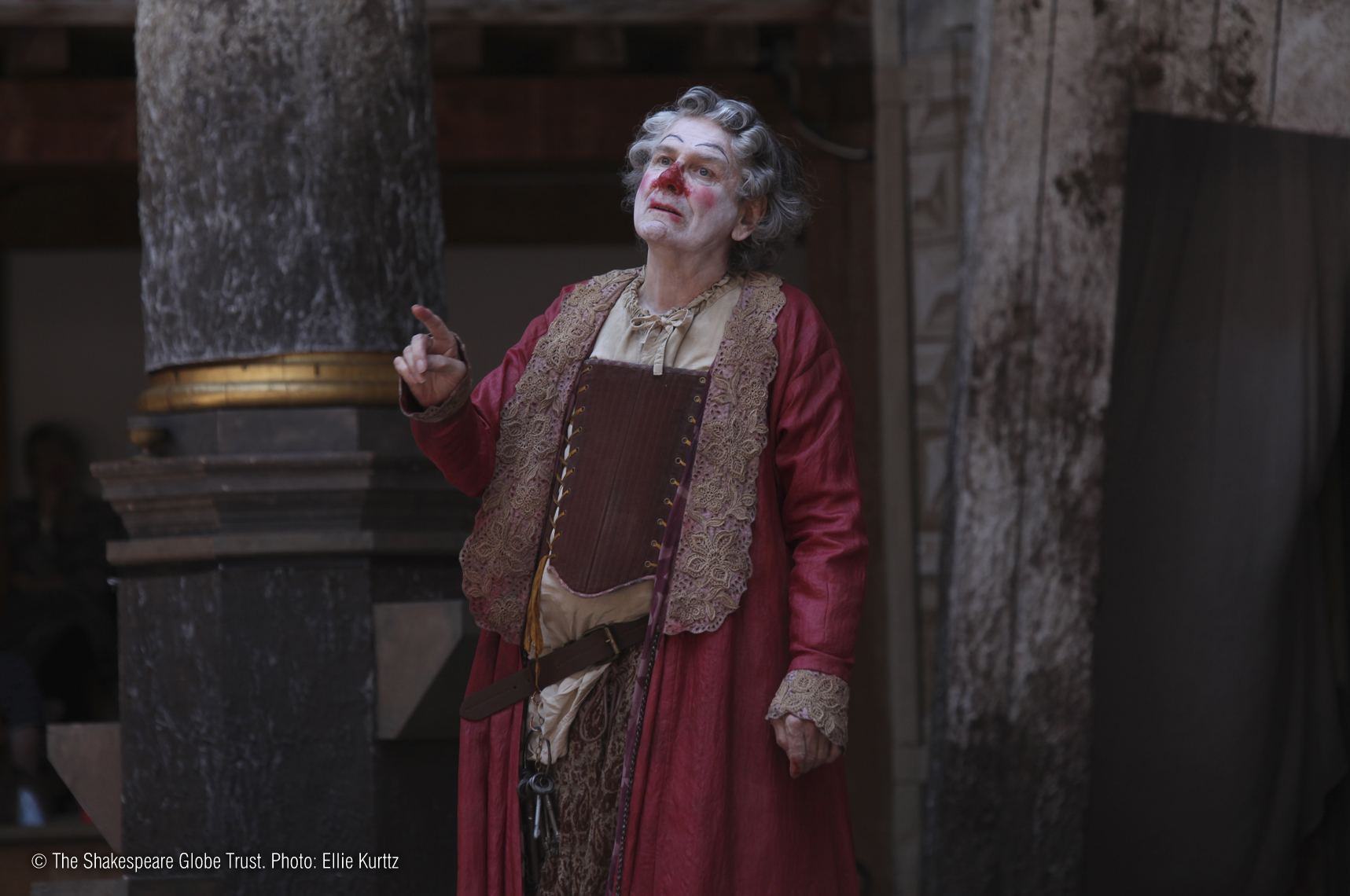
2) Task bank: themes and ideas
The following tasks can be used in the modelling of planning and drafting of written tasks, as well as for students’ more independently produced work for assessment:
- To what extent do you think Macbeth is a play about the bonds that exist between family members?
- What do you think Shakespeare is saying in Macbeth about the use and abuse of power?
- ‘ Macbeth is a play about the battle between good and evil’. How far would you agree with this statement about the play?
How do I annotate my text to show cross-references between different parts of the text?
Why is this an important skill when writing about a substantial text?
Students could prepare a plan in timed conditions for one of the tasks in ‘Task bank: themes and ideas’.
- The tasks in the question banks can be used as the basis for devising further tasks to suit the needs of your own class, curriculum and syllabus.
As homework/revision, students could attempt one or more of the writing tasks from the task bank.
Want to download these resources and more? Log in or sign up to Teach Shakespeare.
Log in or sign up to add your own notes.
KidZone: Shakespeare Creative Writing Prompts
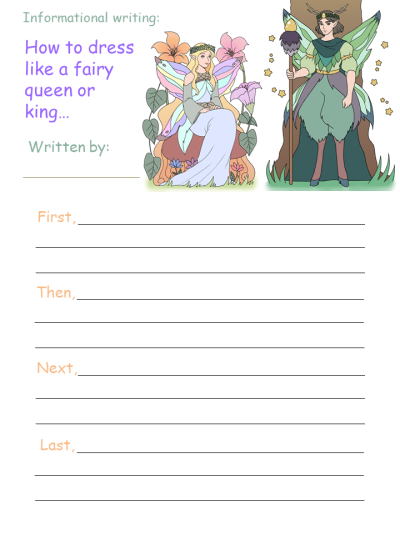
Introduction:
I like to encourage the kids to use their imagination and create their own silly stories inspired by William Shakespeare's plays
There's no need to recreate the story. Just have fun, be silly and don't take it too seriously!
Each worksheet provides a different inspiration to help spark a child's creative writing.
Draw and Write Worksheets: Write a story and draw a picture inspired by the writing prompt. You may wish to provide additional Lined Paper .
Informational Writing Worksheets: First, Next, Then, Last
Use these words to create an informational writing short manual.
Story Spark Worksheets:
Distribute the story spark worksheet and encourage the children to complete the story based on the first sentence provided.
Printable Templates:
Macbeth Creative Writing Activities:
- Macbeth Story Informational Writing
- Macbeth Story Vocabulary Words Worksheets
A Mid Summer Night's Dream Creative Writing Activities:

- Fairies' Story Informational Writing
- Fairies' Story Vocabulary Words Worksheets
- Fairies' Story Writing Prompts (Story Sparks)
- Lovers' Story Informational Writing
- Lovers' Story Vocabulary Words Worksheets
- Mechanicals' Story Informational Writing
- Mechanicals' Story Vocabulary Words Worksheets
Romeo and Juliet Creative Writing Activities:
- Romeo and Juliet Story Informational Writing
- Romeo and Juliet Story Vocabulary Words Worksheets
Share this page
- Share on Facebook
- Share on Twitter
- Share on LinkedIn
EFL Creative Writing: Prospero's Island

This creative writing activity lets students cast their own spell to summon up a tempest.
Related resources
Efl snappy shakespeare script: the tempest.
This reduced script of Shakespeare's The Tempest uses only lines from the play to get students familiar with the material.
EFL Creative Writing: Casting A Spell
Efl the tempest plot summary.
Plot summary of The Tempest, ideal for for familiarising your students with the what and whereabouts.
EFL A Quiz About The Tempest
Take this quiz to review basic plot points and facts about The Tempest.
EFL The Tempest Soundscape
Have your students create the soundscape of Prospero's island.
We use essential and non-essential cookies that improve the functionality and experience of the website. For more information, see our Cookies Policy.
Necessary cookies
Necessary cookies ensure the smooth running of the website, including core functionality and security. The website cannot function properly without these cookies.
Analytics cookies
Analytical cookies are used to determine how visitors are using a website, enabling us to enhance performance and functionality of the website. These are non-essential cookies but are not used for advertising purposes.
Advertising cookies
Advertising cookies help us monitor the effectiveness of our recruitment campaigns as well as enabling advertising to be tailored to you through retargeting advertising services. This means there is the possibility of you seeing more adverts from the Shakespeare Birthplace Trust on other websites that you visit.
- Save settings Minimise
Romeo and Juliet: Creative Writing Assignment

Also included in
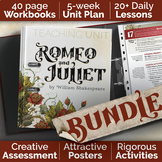
Description
Student handouts, possible rubric, sample assignment, and detailed instructions for this engaging creative writing task for Shakespeare's Romeo & Juliet . Over the course of studying the play, students rewrite three key scenes, getting feedback in the process, and then they select one which best represents their abilities to hand in for summative assessment.
One of the best ways to solidify students' knowledge is through transformation : having them transform a product to evidence the depth of their understanding. This task aims to help them do just that: having them rewrite key scenes from the play as narrative stories.
- Instructions for use
- First Creative Assignment Handout
- Second Creative Assignment Handout
- Third Creative Assignment Handout
- Sample student assignment
- Digital Version
Looking for more resources for teaching Shakespeare's ROMEO AND JULIET?
- TEACHING BUNDLE: Lesson plans, posters, student workbooks, and more!
Questions & Answers
Stacey lloyd.
- We're hiring
- Help & FAQ
- Privacy policy
- Student privacy
- Terms of service
- Tell us what you think

Creative Writing Club – members' area
² navigation, write your own shakespeare story – romeo and juliet.
Romeo and Juliet is about two young people from opposing groups – the Montagues and the Capulets. The young people fall in love but fate seems to be against them. The play is set in medieval Italy (in Verona) where the ‘star crossed’ lovers meet. But in this version, you can choose any setting you like – as long as it includes rival ‘tribes’.
⊕ Go through the steps below to create your story...
1. Choose a setting with two opposing groups:
- vampires vs werewolves
- Chelsea fans vs Arsenal fans
- aliens vs humans
- geeks vs trendies
- noughts vs crosses
- cats vs dogs
- Choose your own opposing groups!
2. Choose four characters to be in the story...
- The boy – troubled teen – he's heart-broken most of the time
- His friend – the understanding sort, full of sensible advice.
- The girl – she's young and very beautiful
- Her cousin – claims he’s not looking for trouble, but always finds it!
- The boy's father – set in his ways
- The girl's father – expects her to obey his every word!
3. Suddenly something happens!
- The girl's cousin challenges the boy to a fight
- The father finds out they've been meeting in secret
- They decide to escape together
- The boy kills the cousin in a fight and is banished
- Choose your own idea
3. 3. 4. Write a poem or a diary entry from the point of view of the boy or the girl. (TIP: Your poem does not have to rhyme)
- International
- Education Jobs
- Schools directory
- Resources Education Jobs Schools directory News Search

Shakespeare Homework Booklet
Subject: English
Age range: 14-16
Resource type: Worksheet/Activity
Last updated
29 June 2018
- Share through email
- Share through twitter
- Share through linkedin
- Share through facebook
- Share through pinterest

Creative Commons "Sharealike"
Get this resource as part of a bundle and save up to 33%
A bundle is a package of resources grouped together to teach a particular topic, or a series of lessons, in one place.
The Tempest
A range of resources focused on The Tempest with homework tasks, contextual information and assessment tasks (both reading and writing) mostly aimed at KS3.
Your rating is required to reflect your happiness.
It's good to leave some feedback.
Something went wrong, please try again later.
lydia_millar13
Empty reply does not make any sense for the end user
missrichardsenglish
Report this resource to let us know if it violates our terms and conditions. Our customer service team will review your report and will be in touch.
Not quite what you were looking for? Search by keyword to find the right resource:
Spring 2025 Semester
Undergraduate courses.
Composition courses that offer many sections (ENGL 101, 201, 277 and 379) are not listed on this schedule unless they are tailored to specific thematic content or particularly appropriate for specific programs and majors.
- 100-200 level
ENGL 201.ST2 Composition II: The Mind/Body Connection
Dr. sharon smith.
In this online section of English 201, students will use research and writing to learn more about problems that are important to them and articulate ways to address those problems. The course will focus specifically on issues related to the body, the mind, and the relationship between them. The topics we will discuss during the course will include the correlation between social media and body image; the psychological effects of self-objectification; and the unique mental and physical challenges faced by college students today, including food insecurity and stress.
English 201 S06 and S11: Composition II with an emphasis in Environmental Writing
S06: MWF at 10–10:50 a.m. in Yeager Hall Addition 231
S11: MWF at 12–12:50 p.m. in Crothers Engineering Hall 217
Gwen Horsley
English 201 will help students develop skills to write effectively for other university courses, careers, and themselves. This course will provide opportunities to further develop research skills, to write vividly, and to share their own stories and ideas. Specifically, in this class, students will (1) focus on the relationships between world environments, land, animals and humankind; (2) read various essays by environmental, conservational, and regional authors; and (3) produce student writings. Students will improve their writing skills by reading essays and applying techniques they witness in others’ work and those learned in class. This class is also a course in logical and creative thought. Students will write about humankind’s place in the world and our influence on the land and animals, places that hold special meaning to them or have influenced their lives, and stories of their own families and their places and passions in the world. Students will practice writing in an informed and persuasive manner, in language that engages and enlivens readers by using vivid verbs and avoiding unnecessary passives, nominalizations, and expletive constructions.
Students will prepare writing assignments based on readings and discussions of essays included in Literature and the Environment and other sources. They will use The St. Martin’s Handbook to review grammar, punctuation, mechanics, and usage as needed.
Required Text: Literature and the Environment: A Reader On Nature and Culture. 2nd ed., edited by Lorraine Anderson, Scott Slovic, and John P. O’Grady.
LING 203.S01 English Grammar
TuTh 12:30-1:45 p.m.
Dr. Nathan Serfling
The South Dakota State University 2023-2024 Undergraduate Catalog describes LING 203 as consisting of “[i]nstruction in the theory and practice of traditional grammar including the study of parts of speech, parsing, and practical problems in usage.”
“Grammar” is a mercurial term, though. Typically, we think of it to mean “correct” sentence structure, and, indeed, that is one of its meanings. But Merriam-Webster reminds us “grammar” also refers to “the principles or rules of an art, science, or technique,” taking it beyond the confines of syntactic structures. Grammar also evolves in practice through application (and social, historical, economic changes, among others). Furthermore, grammar evolves as a concept as scholars and educators in the various fields of English studies debate the definition and nature of grammar, including how well its explicit instruction improves students’ writing. In this course, we will use the differing sensibilities, definitions, and fluctuations regarding grammar to guide our work. We will examine the parts of speech, address syntactic structures and functions, and parse and diagram sentences. We will also explore definitions of and debates about grammar. All of this will occur in units about the rules and structures of grammar; the application of grammar rhetorically and stylistically; and the debates surrounding various aspects of grammar, including, but not limited to, its instruction.
ENGL 210 Introduction to Literature
Jodi andrews.
Readings in fiction, drama and poetry to acquaint students with literature and aesthetic form. Prerequisites: ENGL 101. Notes: Course meets SGR #4 or IGR #3.
ENGL 222 British Literature II
TuTh 9:30-10:45 a.m.
This course serves as a chronological survey of the second half of British literature. Students will read a variety of texts from the Romantic period, the Victorian period, and the twentieth and twenty-first centuries, placing these texts within their historical and literary contexts and identifying the major characteristics of the literary periods and movements that produced them.
ENGL 240.ST1 Juvenile Literature
Randi l. anderson.
A survey of the history of literature written for children and adolescents, and a consideration of the various types of juvenile literature.
ENGL 240.ST1 Juvenile Literature: 5-12 Grade
In English 240 students will develop the skills to interpret and evaluate various genres of literature for juvenile readers. This particular section will focus on various works of literature at approximately the 5th-12th grade level.
Readings for this course include works such as Night, Brown Girl Dreaming, All American Boys, Esperanza Rising, Anne Frank’s Diary: A Graphic Adaptation, Animal Farm, Fahrenheit 451, The Giver, The Hobbit, Little Women, and Lord of the Flies . These readings will be paired with chapters from Reading Children’s Literature: A Critical Introduction to help develop understanding of various genres, themes, and concepts that are both related to juvenile literature, and also present in our readings.
In addition to exploring various genres of writing (poetry, non-fiction, fantasy, historical, non-fiction, graphic novels, etc.) this course will also allow students to engage in a discussion of larger themes present in these works such as censorship, race, rebellion and dissent, power and oppression, gender, knowledge, and the power of language and the written word. Students’ understanding of these works and concepts will be developed through readings, discussion posts, quizzes and exams.
ENGL 240.ST2 Juvenile Literature Elementary-5th Grade
April myrick.
A survey of the history of literature written for children and adolescents, and a consideration of the various genres of juvenile literature. Text selection will focus on the themes of imagination and breaking boundaries.
ENGL 242.S01 American Literature II
TuTh 11 a.m.-12:15 p.m.
Dr. Paul Baggett
This course surveys a range of U.S. literatures from about 1865 to the present, writings that treat the end of slavery and the development of a segregated America, increasingly urbanized and industrialized U.S. landscapes, waves of immigration, and the fulfilled promise of “America” as imperial nation. The class will explore the diversity of identities represented during that time, and the problems/potentials writers imagined in response to the century’s changes—especially literature’s critical power in a time of nation-building. Required texts for the course are The Norton Anthology of American Literature: 1865 to the Present and Toni Morrison’s A Mercy.
WMST 247.S01: Introduction to Women, Gender and Sexuality Studies
As an introduction to Women, Gender and Sexuality studies, this course considers the experiences of women and provides an overview of the history of feminist thought and activism, particularly within the United States. Students will also consider the concepts of gender and sexuality more broadly to encompass a diversity of gender identifications and sexualities and will explore the degree to which mainstream feminism has—and has not—accommodated this diversity. The course will focus in particular on the ways in which gender and sexuality intersect with race, class, ethnicity, and disability. Topics and concepts covered will include: movements for women’s and LGBTQ+ rights; gender, sexuality and the body; intersectionality; rape culture; domestic and gender violence; reproductive rights; Missing and Murdered Indigenous Women (MMIW); and more.
ENGL 283.S01 Introduction to Creative Writing
MWF 1-1:50 p.m.
Prof. Steven Wingate
Students will explore the various forms of creative writing (fiction, nonfiction and poetry) not one at a time in a survey format—as if there were decisive walls of separation between then—but as intensely related genres that share much of their creative DNA. Through close reading and work on personal texts, students will address the decisions that writers in any genre must face on voice, rhetorical position, relationship to audience, etc. Students will produce and revise portfolios of original creative work developed from prompts and research. This course fulfills the same SGR #2 requirements ENGL 201; note that the course will involve creative research projects. Successful completion of ENGL 101 (including by test or dual credit) is a prerequisite.
English 284: Introduction to Criticism
This course introduces students to selected traditions of literary and cultural theory and to some of the key issues that animate discussion among literary scholars today. These include questions about the production of cultural value, about ideology and hegemony, about the patriarchal and colonial bases of Western culture, and about the status of the cultural object, of the cultural critic, and of cultural theory itself.
To address these and other questions, we will survey the history of literary theory and criticism (a history spanning 2500 years) by focusing upon a number of key periods and -isms: Greek and Roman Classicism, The Middle Ages and Renaissance, The Enlightenment, Romanticism, Realism, Formalism, Historicism, Political Criticism (Marxism, Post-Colonialism, Feminism, et al.), and Psychological Criticism. We also will “test” various theories we discuss by examining how well they account for and help us to understand various works of poetry and fiction.
- 300-400 level
ENGL 330.S01 Shakespeare
TuTh 8-9:15 a.m.
Dr. Michael S. Nagy
This course will focus on William Shakespeare’s poetic and dramatic works and on the cultural and social contexts in which he wrote them. In this way, we will gain a greater appreciation of the fact that literature does not exist in a vacuum, for it both reflects and influences contemporary and subsequent cultures. Text: The Riverside Shakespeare: Complete Works. Ed. Evans, G. Blakemore and J. J. M. Tobin. Boston: Houghton Mifflin, 1997.
ENGL 363 Science Fiction
MWF 11-11:50 a.m.
This course explores one of the most significant literary genres of the past century in fiction and in film. We will focus in particular on the relationship between science fiction works and technological and social developments, with considerable attention paid to the role of artificial intelligence in the human imagination. Why does science fiction seem to predict the future? What do readers and writers of the genre hope to find in it? Through readings and viewings of original work, as well as selected criticism in the field, we will address these and other questions. Our reading and viewing selections will include such artists as Ursula K. LeGuin, Octavia Butler, Stanley Kubrick and Phillip K. Dick. Students will also have ample opportunity to introduce the rest of the class to their own favorite science fiction works.
ENGL 383.S01 Creative Writing I
MWF 2-2:50 p.m.
Amber Jensen
Creative Writing I encourages students to strengthen poetry, creative nonfiction, and/or fiction writing skills through sustained focus on creative projects throughout the course (for example, collections of shorter works focused on a particular form/style/theme, longer prose pieces, hybrid works, etc.). Students will engage in small- and large-group writing workshops as well as individual conferences with the instructor throughout the course to develop a portfolio of creative work. The class allows students to explore multiple genres through the processes of writing and revising their own creative texts and through writing workshop, emphasizing the application of craft concepts across genre, but also allows students to choose one genre of emphasis, which they will explore through analysis of self-select texts, which they will use to deepen their understanding of the genre and to contextualize their own creative work.
ENGL 475.S01 Creative Nonfiction
Mondays 3-5:50 p.m.
In this course, students will explore the expansive and exciting genre of creative nonfiction, including a variety of forms such as personal essay, braided essay, flash nonfiction, hermit crab essays, profiles and more. Through rhetorical reading, discussion, and workshop, students will engage published works, their own writing process, and peer work as they expand their understanding of the possibilities presented in this genre and the craft elements that can be used to shape readers’ experience of a text. Students will compile a portfolio of polished work that demonstrates their engagement with course concepts and the writing process.
ENGL 485.S01 Writing Center Tutoring
MW 8:30-9:45 a.m.
Since their beginnings in the 1920s and 30s, writing centers have come to serve numerous functions: as hubs for writing across the curriculum initiatives, sites to develop and deliver workshops, and resource centers for faculty as well as students, among other functions. But the primary function of writing centers has necessarily and rightfully remained the tutoring of student writers. This course will immerse you in that function in two parts. During the first four weeks, you will explore writing center praxis—that is, the dialogic interplay of theory and practice related to writing center work. This part of the course will orient you to writing center history, key theoretical tenets and practical aspects of writing center tutoring. Once we have developed and practiced this foundation, you will begin work in the writing center as a tutor, responsible for assisting a wide variety of student clients with numerous writing tasks. Through this work, you will learn to actively engage with student clients in the revision of a text, respond to different student needs and abilities, work with a variety of writing tasks and rhetorical situations and develop a richer sense of writing as a complex and negotiated social process.
ENGL 492.S01 The Vietnam War in Literature and Film
Tuesdays 3-5:50 p.m.
Dr. Jason McEntee
In 1975, the United States officially included its involvement in the Vietnam War, thus marking 2025 as the 50th anniversary of the conclusion (in name only) of one of the most chaotic, confusing, and complex periods in American history. In this course, we will consider how literature and film attempt to chronicle the Vietnam War and, perhaps more important, its aftermath. I have designed this course for those looking to extend their understanding of literature and film to include the ideas of art, experience, commercial products, and cultural documents. Learning how to interpret literature and movies remains the highest priority of the course, including, for movies, the study of such things as genre, mise-en-scene (camera movement, lighting, etc.), editing, sound and so forth.
We will read Dispatches , A Rumor of War , The Things They Carried , A Piece of My Heart , and Bloods , among others. Some of the movies that we will screen are: Apocalypse Now (the original version), Full Metal Jacket , Platoon , Coming Home , Born on the Fourth of July , Dead Presidents , and Hearts and Minds . Because we must do so, we will also look at some of the more fascinatingly outrageous yet culturally significant fantasies about the war, such as The Green Berets and Rambo: First Blood, Part II .
ENGL 492.S02 Classical Mythology
TuTh 3:30-4:45 p.m.
Drs. Michael S. Nagy and Graham Wrightson
Modern society’s fascination with mythology manifests itself in the continued success of novels, films and television programs about mythological or quasi-mythological characters such as Hercules, the Fisher King, and Gandalf the Grey, all of whom are celebrated for their perseverance or their daring deeds in the face of adversity. This preoccupation with mythological figures necessarily extends back to the cultures which first propagated these myths in early folk tales and poems about such figures as Oðin, King Arthur, Rhiannon, Gilgamesh, and Odysseus, to name just a few. English 492, a reading-intensive course cross-listed with History 492, primarily aims to expose students to the rich tradition of mythological literature written in languages as varied as French, Gaelic, Welsh, Old Icelandic, Greek, and Sumerian; to explore the historical, social, political, religious, and literary contexts in which these works flourished (if indeed they did); and to grapple with the deceptively simple question of what makes these myths continue to resonate with modern audiences. Likely topics and themes of this course will include: Theories of myth; Mythological Beginnings: Creation myths and the fall of man; Male and Female Gods in Myth; Foundation myths; Nature Myths; The Heroic Personality; the mythological portrayal of (evil/disruptive) women in myth; and Monsters in myth.
Likely Texts:
- Dalley, Stephanie, trans. Myths from Mesopotamia: Creation, the Flood, Gilgamesh, and Others. Oxford World’s Classics, 2009
- Faulkes, Anthony, trans. Edda. Everyman, 1995
- Gregory, Lady Augusta. Cuchulain of Muirthemne: The Story of the Men of the Red Branch of Ulster. Forgotten Books, 2007
- Jones, Gwyn, Thomas Jones, and Mair Jones. The Mabinogion. Everyman Paperback Classics, 1993
- Larrington, Carolyne, trans. The Poetic Edda . Oxford World’s Classics, 2009
- Matarasso, Pauline M., trans. The Quest of the Holy Grail. Penguin Classics, 1969
- Apollodorus, Hesiod’s Theogony
- Hesiod’s Works and Days
- Ovid’s Metamorphoses, Homeric Hymns
- Virgil’s Aeneid
- Iliad, Odyssey
- Apollonius of Rhodes Argonautica
- Ovid’s Heroides
- Greek tragedies: Orestaia, Oedipus trilogy, Trojan Women, Medea, Hippoolytus, Frogs, Seneca's Thyestes, Dyskolos, Amphitryon
- Clash of the Titans, Hercules, Jason and the Argonauts, Troy (and recent miniseries), Oh Brother, Where Art Thou?
ENGL 492.ST1 Science Writing
Erica summerfield.
This course aims to teach the fundamentals of effective scientific writing and presentation. The course examines opportunities for covering science, the skills required to produce clear and understandable text about technical subjects, and important ethical and practical constraints that govern the reporting of scientific information. Students will learn to present technical and scientific issues to various audiences. Particular emphasis will be placed on conveying the significance of research, outlining the aims, and discussing the results for scientific papers and grant proposals. Students will learn to write effectively, concisely, and clearly while preparing a media post, fact sheet, and scientific manuscript or grant.
Graduate Courses
Engl 575.s01 creative nonfiction.
In this course, students will explore the expansive and exciting genre of creative nonfiction, including a variety of forms such as personal essay, braided essay, flash nonfiction, hermit crab essays, profiles, and more. Through rhetorical reading, discussion, and workshop, students will engage published works, their own writing process, and peer work as they expand their understanding of the possibilities presented in this genre and the craft elements that can be used to shape readers’ experience of a text. Students will compile a portfolio of polished work that demonstrates their engagement with course concepts and the writing process.
ENGL 592.S01: The Vietnam War in Literature and Film
Engl 704.s01 introduction to graduate studies.
Thursdays 3-5:50 p.m.
Introduction to Graduate Studies is required of all first-year graduate students. The primary purpose of this course is to introduce students to modern and contemporary literary theory and its applications. Students will write short response papers and will engage at least one theoretical approach in their own fifteen- to twenty-page scholarly research project. In addition, this course will further introduce students to the M.A. program in English at South Dakota State University and provide insight into issues related to the profession of English studies.
ENGL 792.ST1 Grant Writing
This online course will familiarize students with the language, rhetorical situation, and components of writing grant proposals. Students will explore various funding sources, learn to read an RFP, and develop an understanding of different professional contexts and the rhetorical and structural elements that suit those distinct contexts. Students will write a sample proposal throughout the course and offer feedback to their peers, who may be writing in different contexts, which will enhance their understanding of the varied applications of course content. Through their work in the course, students will gain confidence in their ability to find, apply for, and receive grant funding to support their communities and organizations.
Resources you can trust
Much Ado About Nothing
Shakespeare's romantic-themed Italian comedy is a popular choice for KS3 students. You'll find a fun selection of classroom resources to explore key themes, language and characters in the play.
KS3 teaching resources
- (-) Show all (47)
- English (46)
- All key stages (51)
- (-) KS3 (46)
- All global tags (149)
- (-) Much Ado About Nothing (46)
- William Shakespeare (46)
- William Shakespeare (41)
- Pre-1900 (7)
Resource type
- Worksheet (30)
- Student activity (22)
- Role play/debate/discussion (6)
- Teaching ideas (5)
- Game/quiz (4)
- Starter/Plenary (4)
- Revision (2)
- Complete lesson (1)
- Display/posters (1)
- Homework (1)
- Scheme of work (1)
Search results

IMAGES
VIDEO
COMMENTS
Remind them that their writing should reflect what they know about the character, revealing that character's opinions, motivations, or emotions in some way. Shakespearean Mash-up. Ask students to imagine a Netflix director is calling for proposals for a new television series called Shakespearean Mashup.
Free Creative Writing Prompts: Shakespeare. 1. Compose a sonnet to the love of your life. This person can be living, dead, with you, not with you, etc., it doesn't matter because it's a sonnet! Try using iambic pentameter and the rhyme schemes of the bard himself. 2. You have suddenly become transported into your favorite Shakespearian play and ...
Hexagonal thinking is a great way to inspire Shakespeare discussions. Get kids moving their ideas around and connecting them into webs of connection, debating, discussing, and defending all the while. If you've never heard to hexagonal thinking, you're going to love this creative strategy!
Here you can access and download our Activity Toolkits for independent and home learning, offering creative and exploratory activities for students. The Activity Toolkits each contain a number of short 15 minute activities on each play. These are ideal for remote learning tasks, as a an extension to classroom or online work or for use as part ...
Get it: Mama Jenn. 26. Shakespeare's Life Poster. Hang this tongue-in-cheek timeline of the man himself to give students an overview of his life. Get it: Imgur. 27. Shakespeare Plays Word Search. Print this simple word search to familiarize your class with Shakespeare's plays. Get it: Word Search Addict.
William Shakespeare. Time period. Pre-1900. Genre. Heritage. A set of creative writing tasks in which students script a scene from a Shakespeare play without realising it's Shakespeare they're recreating! The resource has six different writing cards with a plot overview and writing prompts. 43.5 KB.
Activity 3: College to Adult: Visual Art of Midsummer Nights' Dream Project. Objective: Design costumes and setting for Dream to get the students thinking about the visual language of the play, which takes place in three very distinct locations. Materials needed- depends on the format.
Discover writing activities and ways into teaching literacy, inspired by Michael Morpurgo's Tales from Shakespeare. Created in collaboration with Jan Anderson, an RSC Associate School teacher from Springhead Primary School, these resource packs offer brilliant ways into teaching writing outcomes as part of your study of Shakespeare at KS1-3.
Sneaky Shakespeare works as an engaging pre-reading task with a range of creative writing cards and prompts for adaptations. Shakespeare revision ideas for KS4-5. If you are consolidating students' understanding, revising a Shakespeare play, or preparing students for an exam question, you might want to focus on ways to recall key quotations.
For a comprehensive resource pack, including teaching resources, worksheets, PowerPoints, sequencing tasks and lesson plans, try our The Tempest teaching pack, designed specifically for key stage 3 students with a mix of analytical, creative and drama activities. You can also find a range of resources on Shakespeare's life and context.
Macbeth: Themes KS4/5. In these lessons, students will engage with the themes and ideas at the heart of the text, including deception, ambition, and guilt. Tasks include: tracking these themes throughout the play, drawing out key quotations; creative writing on Lady Macbeth's sleep walking, in the character of her doctor; and a list of practice ...
Each worksheet provides a different inspiration to help spark a child's creative writing. Draw and Write Worksheets: Write a story and draw a picture inspired by the writing prompt. You may wish to provide additional Lined Paper. Informational Writing Worksheets: First, Next, Then, Last. Use these words to create an informational writing short ...
This creative writing activity lets students cast their own spell to summon up a tempest. Come and learn from us in person! Our Shakespeare experts deliver educational sessions to people of all ages from around the world. A creative writing activity in which students write and share their own description of the island in William Shakespeare's ...
Description. Student handouts, possible rubric, sample assignment, and detailed instructions for this engaging creative writing task for Shakespeare's Romeo & Juliet. Over the course of studying the play, students rewrite three key scenes, getting feedback in the process, and then they select one which best represents their abilities to hand in ...
It's a fantastic, complex and meaningful story. Using writing prompts help children to analyse and focus on different aspects of Shakespeare's piece. It's also a great tool for highlighting the use of linguistic devices and techniques. You can encourage kids to think about how Shakespeare captures the different aspects of human experience.
This writing activity satisfies the following Common Core Standards. W.9-10.3 Write narratives to develop real or imagined experiences or events using effective technique, well-chosen details, and well-structured event sequences. W.9-10.4 Produce clear and coherent writing in which the development, organization, and style are appropriate to ...
Activity: (Folger Pre-‐Performance #8) Macbeth rarely speaks directly of killing Duncan. Instead he uses less brutal language, or euphemisms. As a class, read the speech in 1.7.1-‐28 underlining all the words that refer to the murder of Duncan (there are at least 12).
Hooking students into Shakespeare can be a daunting task. There's the language barrier, the different time period, funny clothing, acting…. it's no wonder students can be reluctant at the beginning of a Shakespeare unit. But here are ten engaging ways to introduce a Shakespeare unit that will hook them from the first day.
doc, 375.5 KB. A fully made ready to teach SOW for a KS3 introduction to Shakespeare including a fun creative writing task involving context and being a 16th century audience member going on a trip to the Globe theatre. Rest of the SOW focuses on A Midsummer Nights Dream. Involves analysis tasks, creative writing tasks as well as general ...
Romeo and Juliet. Romeo and Juliet is about two young people from opposing groups - the Montagues and the Capulets. The young people fall in love but fate seems to be against them. The play is set in medieval Italy (in Verona) where the 'star crossed' lovers meet. But in this version, you can choose any setting you like - as long as it ...
The Tempest. A range of resources focused on The Tempest with homework tasks, contextual information and assessment tasks (both reading and writing) mostly aimed at KS3. was £4.00. An A5 sized booklet for easy use with planners with three homework tasks based on Shakespeare. Tasks are project-based and include research, creative making and writ.
Title. Twelfth Night. Free. This resource includes seven comprehension questions on the first Act of the play and a selection of engaging writing tasks. 40.96 KB. Free download. Add to favourites. Facebook Twitter Pinterest Mail. Get to grips with the opening scenes of the play by answering these comprehension questions.
ENGL 283.S01 Introduction to Creative Writing. MWF 1-1:50 p.m. Prof. Steven Wingate. Students will explore the various forms of creative writing (fiction, nonfiction and poetry) not one at a time in a survey format—as if there were decisive walls of separation between then—but as intensely related genres that share much of their creative DNA.
Much Ado About Nothing. Shakespeare's romantic-themed Italian comedy is a popular choice for KS3 students. You'll find a fun selection of classroom resources to explore key themes, language and characters in the play.